1996 Lexus ES 300: What's It Like to Live With?
Read the latest updates in our long-term road test of the 1996 Lexus ES 300 as our editors live with this car for a year.

What do you want to know about?
- Introduction
- A Macro Look at Interior Materials
- A Remarkable Find
- Vegas Road Trip
- Tracking our Fuel Economy
- Stranded
- DIY Troubleshooting
- The Extended Repair
- Zydeco Speedo
- DIY Key Fob Battery
- Coast to Coast
- A Whole Lotta Nowhere
- Hood Strut Fail
- Crosswind Noise
- Peace of Mind
- Preventive Maintenance
- Props for Quick Repair
- Made it to the Atlantic
- Leaps and Bounds
- A Nagging Problem Fixed
- Front Brake Change
- Back Home Again
- Don't Be A Snob
- Will The Bike Fit?
- Must Wear Gloves
- License Plate Bracket
- Waxing Appreciative
- Terminal Transportation
- The Rontoya Replies
- Oil Change and Tire Rotation
- Wayback Machine
- Fast Blinkers
- Fast Blinkers Part II
- Local Phenomenon
- Twilight or Endless Summer?
- What More Do You Want?
- Increasingly Cheap and Cheerful
- Driving Without Shame
- Listen to Your Dad
- What Were They Thinking?
- Kumba-yikes!
- Fuel Economy Stats
- Checking Fault Codes with CarMD
- New Hood Struts
- Droopy Visors No More
- Undiscovered Country
- Hood Struts DIY
- Car Show Material?
- A Priceless Piece of Americana
- The World's Best Commute Car
- Elbow Friendly
- Service @ 150K Miles
- Midyear Check-In
- Air Leak From The Wheel
- Enjoyable Highway Cruiser
- 150,000 Miles
- Sleeps With The Fishes
- Update On No-Start Problem
- At The Shop
- Back In Action
- Reminds Me Of
- A Couple Other Minor Issues
- Proper Throttle Response
- Off Brand Vs. Major Brand Gas
- The View
- 150K + Maintenance = Uncharted Territory
- It's the New Volvo Amazon
- Cataracts
- The Racer's Choice
- A Clean Well Lighted Car
- Let There Be (Better) Light
- Tighten Your Timing Belt
- Silver Trumps Gold
- Name the Stain
- Rainy Weather Performance
- Helmets Optional
- New Headlight Bulb Impressions
- Broken CD Changer
- Death Valley Road Trip
- CD Player is Just Fine
- Broken Door Fixed
- Could Not Duplicate
- Oxygen Sensor Fixed
- January Fuel Economy Update
- Tape Player Review
- Sunnyy Greenhouse
- On Its Last Legs?
- Gauge Lights Fixed
- Check Engine...Again
- Fuel Economy Update for February
- Repeat Business
- Jiffy Lube Vindicated
- Passed Smog
- Bonding
- Farewell, Old Friend
- Wrap-Up

I bet you didn't see this one coming.
We set out to buy a car for no more than $3,500 that wasn't a beater. We're calling it our Debt-Free Car Project.
Not everyone can afford car payments. But you don't have to drive around in a hunk of junk if your budget is limited to a few thousand dollars.
It took some searching and patience but we did it. We ended up with a 1996 Lexus ES 300 with 135,000 miles on the odometer. We have 12 months to see how it will hold up.
.

Looking at these close-up shots of our 1996 Lexus ES 300's interior, one can't help but marvel over how well it's held up considering we found it in the back lot of a tiny independent car dealership. Sure, there is the matter of a missing passenger-side sun visor, some minor stains on its beige rug and some wear on the steering wheel but nothing major. Check it out for yourself.

Not all the seats are crusty like this. In fact this is just the worst part, which is on the seat bolster of the driver seat, but not as bad as it is in our Miata.




I "broke in" our recently acquired 1996 Lexus ES 300 this weekend and even though most wouldn't give it a second glance (here it is getting shined at the car wash), I have to say it's a pretty remarkable car. Not only is it in such great condition for a 138K car but it cost us under $3,500.
And I know by now you've probably read up on our Debt-Free Car Project, but this car's amazing story particularly hits home with me because I have a friend who was looking for such a deal for MONTHS. And honestly, I didn't think such a car existed for him — one that still ran well, was in good condition, didn't have a salvage title and was so cheap — especially after it seemed like every search he did turned up really questionable choices.
Since I work for Edmunds, I felt it my duty to warn him away from car salesmen who refused to price their vehicles at TMV, and especially those selling salvage-title cars with missing airbags.
But here was our 1996 Lexus ES 300, accident-free and in impressive running condition. It showed me to not lose hope for my friend. In the end, however, after a lengthy search and many dead ends he finally settled on a 1996 Camry that had a salvage title and a missing sunroof window. He paid $2,500 for it. His car still runs well but I kinda wished he lucked out like we did.

Last month, I drove our long-term Lexus ES300 to Las Vegas to attend a Buy Here Pay Here (BHPH) Dealer convention, at the organization’s invitation. This BHPH convention was a gathering of dealers to discuss best practices and to get a feel for where the industry stands at the moment.
It was actually the second Vegas run the car made after we purchased it, but I’ll leave the story of that trip to Phil Reed, our senior consumer advice editor, who is on sabbatical until July.
As we discussed our convention visit with one of the dealer association’s representatives, he questioned whether an average buyer could find a reliable and inexpensive used car in our target $3,500 price range, since it was tough for the dealers themselves to find anything decent for under $5,000.
Buying our Lexus wasn't a cakewalk, but it was certainly doable, and we found one for much less than $5K. Since the convention was being held in the far corner of the Caesar's Palace, I didn't have the chance to show off the car to the convention attendees. But I took comfort in knowing that the car made it to Vegas and back without any issues.
As for the trip itself, I found the Lexus to be very comfortable to drive in long stretches. The cruise control and auto climate control both work and I used them for most of the way. I drove a total of about 600 miles and I was pretty consistent with my driving style. My first tank on the way to Vegas, and a portion of the return trip, I averaged 27.4 mpg. I drove less miles on the return tank and also averaged 27.4 mpg. This is almost 1.5 more mpg than the EPA's highway estimate.
For entertainment our Lexus has a tape deck in the front and a multi-disc CD changer in the trunk. My colleagues suggested I get a tape adapter so I could listen to the full music collection on my iPhone, rather than be limited to a few CDs. But I went with something more modern. I have a portable Bluetooth speaker that I placed on the front seat. This device has great sound quality for music, and also has a microphone so I could take calls. I kept my iPhone’s battery topped off with a car charger that plugged into the cigarette lighter.
This setup was working well enough until I realized I couldn't turn off the speaker. Sitting in the sun had fused the speaker’s power button into a permanent "on" position. I'm hoping it's still under warranty.

We mentioned that we would keep track of fuel economy and costs in our introduction of the Lexus ES300. The Edmunds testing team typically has a spreadsheet to make these calculations, but it does not keep track of fuel costs. We're big fans of a Web site called Fuelly.com, which is where we created an account for our Lexus.
This site keeps track of your fuel economy data, and presents it in a number of tables and charts. You can compare your data to vehicles like yours, and even look at what fuel economy other cars are getting. Fuelly also makes it easy to share your data via Facebook, Twitter or even as a forum signature. If you are away from the computer, you can use the mobile site to update your stats.
As you can see our Lexus is averaging about 23 mpg and costs about $0.19 cents per mile to operate. The best mpg is held by yours truly. We're paying an average of $4.35 per gallon.
According to the EPA, the 1996 Lexus ES300 has an estimated fuel economy of 18 mpg in the city, 26 on the highway, and a combined 21 mpg. These numbers are the EPA's revised versions, not the original numbers that appeared on the window sticker.
One final note: Take our "City vs Highway" pie chart with a grain of salt. This is just a slider that you select when you are inputting your data. If you do nothing, it defaults to a 50/50 split.
Follow this link to view the stats on our Lexus.
http://www.fuelly.com/driver/debtfreecar/es300


<sad trombone>
Tried to leave for the office on Friday in our longterm 1996 Lexus ES300 and was greeted by a general difficulty to start. Plenty of cranking power, but it took some throttle to catch and keep it running. It would die if I lifted. Never lift!
I suspected the idle air control valve and even attempted a quick DIY cleaning of it. No dice. There was no way I was going to try to limp this thing to the office in L.A. stop-and-slow traffic, so I called in for reinforcements.
My esteemed colleague Ron Montoya, cousin of Inigo, has more details and will give y'all an update in the near future.

Our long-term Lexus ES300 left us stranded last week. Jay suspected the idle air control valve was the culprit. I ran a Google search on this and found a YouTube video that had a familiar scenario. The car in the video is a Camry, but it has the same engine as our Lexus.
Bloody knuckle aside, it seemed simple enough. And if a $4 bottle of carburetor cleaner would solve our issue, why not give it a try? The goal of our Debt-Free Car Project is to duplicate the average person's ownership experience. As such, we want to keep costs down and find alternative solutions. So we opened the hood, propped it up with our makeshift prop rod, (Yes, the car needs hood struts) and went to work.

It took Jay less than five minutes to remove the air intake hose. He sprayed the small opening in the throttle body as the video had instructed. We waited for the cleaner to dry, put the hose back on, and started the car. No go.
I was disappointed that this fix didn't work, but I'm glad we gave it a shot. Otherwise, I would have always wondered if we could have avoided a potential costly repair.
I called a tow truck and had them take the Lexus to an independent shop a few blocks away from the office. Neither Jay or I had AAA, so we had to go out of pocket on the tow. The nine mile trip cost $141.
To be concluded.

After nearly a week of being out of commission, our long term 1996 Lexus ES300 is back in the fleet. There's a long story behind the delay, but first I want to address a couple of comments and misunderstandings.
1. A number of readers have suggested that we handle every repair on this car as a DIY project. As I mentioned in the last blog, this project is trying to duplicate what the average person might do when owning an inexpensive used car. I work for Edmunds and I even worked in the parts department of a dealership (shipping and receiving) but this doesn't mean that I am qualified to fix a car. In fact, I avoid DIY projects. I don't have the patience for it and I usually end up breaking things. In that respect, I am like the average person. I tried a quick fix, it didn't work, and then I took the car to a mechanic. That’s what most people would do. And that's what we intend to do with any future repairs.
2. We never had the chance to try out nsx603's potential fix because the blog was written days after the car was in the shop. Think of this blog as a parallel universe. Just because it was posted on the blog, doesn't mean it happened that day.
Now that we've tempered the gear heads expectations, we can move on to what actually happened. I had trouble coming up with a place to take the car to because I didn't really know of any reputable independent garages, much less one near the office. I have always taken my personal cars to the dealership. Same goes for the Edmunds fleet cars. Yes, I know you can spend less at an independent garage but this is my preference. In anycase, I remembered someone telling me about a garage a few blocks from the office. It had good reviews on Yelp, so I gave it a shot.
We brought in the Lexus on a Friday afternoon. I got a call from the mechanic that evening. The mass airflow sensor needed to be replaced and the OEM part cost $1,000. The mechanic told me he would try to find a cheaper alternative over the weekend.
I had a busy Monday and I didn't have time to check on the car. On Tuesday morning I called the mechanic. He said he called a number of places over the weekend but couldn't find anything cheaper than the $1,000 factory part. I told him I would find something myself and bring him the part. His $1K price wasn't off base. One place I called was asking $980 for a non-factory part.
It took me five minutes to Google an O'Reilly auto part shop nearby, call them, and find the part for $220 (plus a $39 core deposit, which was refunded later). The place was less than five miles away from the mechanic. I can't attest to whether the guy looked that hard or if he even tried. I ordered the part but it was not in stock. It would be delivered the following morning.
At the same time, I knew that the Lexus was leaking coolant. I had filled it with coolant to the "max" line and it had dropped to the "low" line in a week. The mechanic confirmed that it needed a new heater valve. O'Rielly was asking $40 for the part. An independent parts shop nearby had quoted me $25 over the phone. When I arrived the employee brought out a part that cost $72. I mentioned that I was quoted a different price. The man I had spoken to on the phone remembered our conversation and showed the other employee that there was a cheaper alternative. I ended up getting the part for $20.
Our imaginary debt-free driver has now been out of the car for three days and has had to borrow a buddy’s car to buy the cheaper parts. I'm subtracting one day for the day I was busy.
It was now Wednesday. I picked up the parts from both shops and took them to the mechanic. He was surprised that I found the inexpensive parts and agreed to install them both for $140.
I called the mechanic Thursday morning. He said he had finished the repairs late the prior night. I picked up the Lexus and it ran fine.
Clearly this repair took way too long and I won't be going back to that same shop. Some might argue that if it were my own car, I would be raising hell until it was fixed. That's not really my style. I'm a low key guy. Perhaps my calls may have been more frequent if it were my car, but at the end of the day this car is a work project.We're trying to duplicate the average person's experience, but we aren't beholden to it. I had a busy week at work and I attended to it when time permitted.
Total Cost (Including sales tax): $420
Days out of service: 6

I've driven our ES300 a half-dozen times since we acquired it, and have taken advantage of its cassette player to dust off and listen to some old mix tapes, a bit of Windham Hill and some Kate and Anna McGarrigle. Ah, youth.
As I was playing a Cajun/zydeco compilation a couple weeks ago, I realized I wasn't the only one who liked the Louisiana groove. Hit the jump to watch our car's speedometer dance along.
Maybe we should take it down on the bayou for some crawfish etouffee.

The 1996 Lexus ES 300 has a small button on the head of the key that can lock and unlock doors (The button is at the 4 o'clock position if you're looking at the photo above). The signal range isn't very far, but it's better than having to manually unlock the doors. When we first purchased the vehicle, the battery on both our key fobs was dead. And for a while, we were unlocking our doors in a manner unbefitting of a luxury car.
My colleague, Phil Reed, purchased the necessary batteries at Radio Shack for $5.99 a piece. Phil replaced the first battery and I did the spare key. That's about the limit of my DIY skills. The process went as follows:
I started out by removing a tiny screw on the back of the key fob with a Phillips screwdriver. The plastic cover needed a little coaxing from a flathead screwdriver, but it came off relatively easy. I used that same flathead to pop out the old battery and then put in the new one. I screwed the cover back on and was done in about 20 minutes.

I pressed the unlock button to test it. The Lexus made an electronic beep when the doors locked and unlocked. The volume can be adjusted by a small knob on the lower left dash board.

Here's our 1996 Lexus ES 300 parked by the Pacific Ocean. In about a week it will be parked by the Atlantic Ocean. I'm driving across country, something I've never done before, and decided to do it in the Lexus. Of course I'll be a bit nervous after its recent "issues." But as a good friend of mine said, "By now, it's fully sorted."
I'm taking the northern route through Chicago, Detroit, and New York State to Boston. On the return trip I'll take a more southern route through Denver and back to Los Angeles.
Thinking ahead to my trip, I keep remembering the famous line from the Blue Brothers as they set out for Chicago: "We've got a full tank of gas, half a pack of cigarettes, it's night and we're wearing sunglasses. Hit it!"

My route took me through a section of the West I'd never seen before — eastern Nevada. Looking at a map I thought it would be incredibly barren and visions of being stranded miles from any garage filled my mind. But once I got rolling on Highway 93, I realized I was in for a treat. The road follows a series of valleys with green meadows, towering cottonwood trees and grazing cattle. I arrived in Wendover, Nevada, a total distance of 640 miles, without any mishaps.
Reading the comments to my first blog I was really happy that so many readers dug the idea of a road trip in a beater. But I realized I didn't introduce this project very well. I should have mentioned that we've had the Lexus checked by no less than three different mechanics including a mechanic from a dealership. We also bought new tires and a new battery for it as soon as we got it. We've done all we can do and if there is some gremlin lurking deep in the engine that's just a reminder of the uncertainty of life itself.
Still, when I'm miles from nowhere, and I feel what I think is a misfire, my heart skips a beat. But during this long drive the ES's motor churned away faithfully and delivered 28 mpg. The seats are definitely old school with only a suggestion of lateral support. But the leather is polished so it's easy to slide around on the seats when you get restless from sitting too long. What I like is the way the low beltline and the skinny A-pillars give a good view of the scenery.
Highway 93 also provided an interesting surprise, which is on the jump.
This is Extraterrestrial Highway which is near Area 51. I didn't dare go any farther for fears of alien probings.


Jay knew it. Phil Reed probably figured it out at some gas station in Utah. The hood struts on our 1996 Lexus ES300 are one of several "little things" that have seen better days and need attention. At the moment, checking the oil is a two-person operation if you aren't in possession of a suitable sawed-off broom handle, though I suppose one could use his or her own head to prop the hood open.
This is a fairly common problem for older hoods and hatches that are held aloft by gas struts, and the solution is fairly simple to execute: buy a new pair of struts for $20 to $25 apiece at our local auto parts store and snap them in place.
I remember an el-cheapo plastic clip device I once installed onto one of the failed struts on a Honda CRX I once owned. It worked well enough holding the hatch open but did not make lifting it any easier. But the cost was more to my liking at the time, something like 5 bucks. I wonder if they still make them today.
Not even close. There isn't even a little bit of support left. Adding this to the DIY list after Phil gets back.

For the past two days since I left Wendover, Nevada, I've been driving through a wicked crosswind. Tumbleweed is flying across the road, trees are bending, windmills are spinning and flags are snapping. When there's no crosswind, the 1996 Lexus ES 300 is nice and quiet. The weather stripping around the doors seems to hold out the wind noise just fine. But this crosswind has created a horrible turbulence in the driver's side window next to my left ear. It sounds like a hurricane.
I've noticed that when I pass an 18-wheeler I hit a zone of silence just as I approach the rear left back wheels of the truck. I have about 45-seconds of blissful stillness and then, when I approach the front of the truck, the racket starts up again. It's a wonderful demonstration of the importance of aerodynamics.
I've check and it doesn't look like the weather stripping around the driver's door is at fault. In fact, I think this same thing might happen in many newer cars since aerodynamics are design to deal with wind coming over the car from the front, not from the side. However, I have noticed that, here and there, bits of black plastic flashing between body panels on the Lexus have dried and, in some cases are curled up and flapping in the wind. I'm tempted to buy some epoxy and clue them back into place but so far, I haven't had the time.
Other than that, this old car is running fine and carrying me 600 miles closer to the Atlantic Ocean each day.

I'm fully prepared to deal with any medical emergencies that might arise on my cross country trip, I'll quickly go to the trunk and use first aid kit which has been resting there, undisturbed since the car was purchased some time in 1995 (note vintage bandages).
Just under the first-aid kit you'll notice an equally ancient CD changer. Before leaving, I got three hefty books on tape to take me across country and back. Stephen King's novel 11/22/63 has 30 discs! I loaded up the cartridge. When I pressed play all I got was an error message. At first I thought it was going to be an awfully long trip. But then I remembered something. When I first started working at Edmunds I used a similar cartridge and the discs had to go in upside down. At the next rest area I flipped all of my discs and — success! Now have a gripping tale to help me pass the time as I drive.

The second chapter of our Debt-Free Car Project is now live. It goes over the first service, an oil inspection, new tires and some suggested items to repair. A number of readers were curious about which tires we purchased. We bought a set of Kumho Solus KR21 for $83 each. Follow the link to read more details.
The Debt-Free Car Project Chapter 2: Preventive Car Maintenance

Dan Edmunds was right — I found out how to prop open the hood of the 1996 Lexus ES 300 in a gas station in Utah. I used my Scotty Cameron putter. It provided great touch and feel. Most importantly, it gave me confidence to stick my head under the hood and check the oil and the coolant level.
I was checking the oil every other tank of gas and keeping an eye on the coolant level. However, as I was approaching my friend's house in Detroit last Thursday, I saw the temp gauge rising. My GPS showed I only had 3.4 miles left so I decided to go for it. As I rolled up out front of his house the needle was climbing. All I could think of was all the barren stretches of road where the Lexus could have overheated. Instead, it was nearly at my friend's house. Talk about great timing.
Early Friday morning, I followed my friend to a local Toyota dealership, Fox Automotive of Rochester Hills. The service advisor, encouragingly named Bradley Ernest, said they had a very full schedule and, if parts were needed it would have to have to wait until Monday. I told him I was driving cross country and needed to leave Sunday morning. I also asked him to change the oil and rotate the tires. Having done all I could, I did the only logical thing: went out and played golf.
When I got done, I had a message from Brad. I called him back anticipating a long song and dance about delays and extra charges.
Instead, Brad told me, "You're good to go."
"What do you mean?"
"It's all fixed. Come and pick it up."
When I got back to Fox, the Lexus was washed and waiting for me. Brad informed me that the hoses leading into the firewall were loose and the coolant had been leaking from there. Also, the radiator cap didn't hold pressure so they replaced it. The total bill for all items was $178. It seemed a little steep but I was rolling again and ready to stay on schedule.
Today I left Detroit, holding my breath and half suspecting that the leak would somehow reappear. But the temp gauge we level all day through 90 degree heat. Tomorrow I will be in Boston and halfway done with my trip.

Eight days ago this 1996 Lexus ES 300 was parked beside the Pacific Ocean. Now, here it is beside the Atlantic, in the small town of Noank, Connecticut. I took the long route so the trip meter is now showing 3,450 miles. I had one mishap — the car overheated in Detroit due to an earlier faulty repair. Other than that, and a rock chip in the windshield, it's been smooth sailing.
We are doing this project to show that a car with 142,000 miles (and climbing rapidly) is dependable. This probably isn't news to people that know cars and realize how incredibly reliable cars have become. The advent of fuel injection has helped enormously (cars now start in the cold and run more efficiently) and so has onboard computers that monitor various sensors in the fuel and exhaust streams. But since 1996 there have been a lot of creature comforts and new features that this old guy doesn't have.
The feel of this Lexus is vastly different than the new cars. The suspension is so soft it reminds me of my Dad's '65 Chevy wagon, the seats are almost like benches, the storage is poor and the cup holders are almost unusable (small and too close the dashboard). But on the plus side, the visibility is wide open, it's quiet, roomy and comfortable with a Big Gulp trunk. And I'm getting about 29 mpg on the highway. It's not going to carve canyons, so I consider its handling to be a non-issue. Hey, it's a point A to point B car. And as for the gold kit, my Dad thinks it looks sharp.
I really appreciate the comments on the posts about this trip. Some have requested a wrap up when I get back home. I'll certainly pull everything together when I finally get back to Los Angeles which, hopefully, will be in a week and change.
By the way, this picture was taken in the parking lot of Costello's Clam Shack (picture below), a seafood joint right on the dock. Next door is a similar restaurant with a related name. Together the names evoke the memory of a great comedy team from early television. What is the other restaurant called?


This 1996 Lexus ES 300 eats up the highway nearly as well as any newer car. I drove from Worcester, Mass., to Cleveland, Ohio, a distance of 626 miles, in one day. Today I made it from Cleveland to Columbia, Mo., a distance of 676 miles. I would have pushed on but I ran into a violent thunderstorm with thick bolts of lightning exploding all around me. So I stopped in the Bates Motel.
Today's trip included a detour to Danville, Indiana, where I lived in this house when I was in second grade. I wish my old house had aged as well as this Lexus. But at least they were proudly flying the flag.
There has been one minor maintenance issue with the Lexus which I will cover in the next blog. But I'll ruin the suspense — it didn't delay me or cost any money. Stay tuned.

I've been holding off writing about this because I wanted to have some resolution before I said anything. The first day of driving cross-country the check engine light came on. My approach to CELs is to see if there are any sudden new noises, weird smells, a change in performance or a drop off in fuel economy. If the answer to all these things is no, then reading the code can wait. Since none of these warning signs were present, I decided to look for the first chance to read the code but kept driving.
The next day the CEL went off. And then the following day the CEL came on again. Since it was going on and off it seemed that whatever was triggering the light was borderline.
When I reached my father's house in Barre, Mass., I used his code reader and got a code of P0401. A quick Google search showed that this was caused by the EGR (exhaust gas recirculation) valve. I found a wonderful little how-to about fixing the EGR valve, which showed me how to locate it on the top of the engine. I was pleased with what I found.

A small hose was lying unconnected on top of the EGR valve (near the yellow tip of the pen I set on it). The hose may have inadvertently been knocked off when other work was done on the engine. It was a simple matter to push it back into place. I used the code reader to clear the code and, 1,500 miles later, it hasn't reappeared. And I've made it all the way to Colorado where I'm staying with my brother in the mountains above Denver.
Wouldn't it be nice if all repairs were this easy?

Here's a little secret: I installed new pads and rotors on our 1996 Lexus ES300 a few days before Phil set off on his trip.
Our car had a persistent shake and steering wheel shimmy under braking, a sign of uneven front rotors. A quick check revealed a thinnish pair of front discs that had been turned more than once already. Turning them again was not an option; new ones were in order.
The brake pads weren't necessarily on their last legs, but we decided to match new with new and swap them out, too.
From there Ron Montoya and I made two decisions in the spirit of the debt-free car project: 1) we would shop around for cheaper non-factory parts at local auto parts stores, and; 2) we would change those parts ourselves. After all, brake swaps are not terribly difficult in the grand scheme of potential DIY maintenance projects.
On the first point, Ron did very well. He paid $32 apiece for the rotors and $44 for a set of pads. Our out-the-door price with tax was $118. Later on I spent $5 for a can of high-temperature disc brake grease/quieting compound.
As for the second point, I'll post a DIY pictorial later.
For now it's enough to say our Lexus has new front brakes and the shimmy is gone. We should be good to go for another 30,000 miles or more. Best part is we got all that for less than $125.

The 1996 Lexus ES 300, aka the "Debt-Free Car," made it from California to Massachusetts and back again, logging 6,834 miles in 16 days. The Lexus now has a hefty 145,786 miles on the clock. There was one problem when the car overheated in Detroit. It was an inexpensive fix, costing only $126 to retighten two hoses and replace a radiator cap. An oil change and tire rotation was performed at the same time. Other than that, and an on-again off-again check engine light, the ES perform admirably.
Here are a few other thoughts about this odyssey.
In the final miles of the drive I found myself wondering whether the trip would have been a lot more comfortable in a brand new car. The answer is, obviously, yes. But that isn't to say that this trip was uncomfortable or this 16-year-old car was sadly lacking. It cruised quietly and efficiently at highway speeds and strong cross winds couldn't knock it off course. It even climbed well in the high oxygen-starved passes of the Rockies with surprisingly smooth down-shifts providing adequate power. The 18-gallon gas tank allowed 400-miles between gas stations and the fuel efficiency was always in the high 20s on 87 octane.
As noted before, the lack of storage space around the driver was annoying, as was the 6-disc CD cartridge in the trunk. The simple addition of a windshield mounted $100 GPS guided me without any problems.
One major difference between this old car and any modern counterpart was the suspension. The struts are tired and the suspension setup is out-dated. Most of the time I didn't notice these shortcomings. In fact, the ES is a great cruiser. But get it on rough pavement, or put it into a sharp corner, and the difference becomes apparent.
Like with so many other issues, the trade off is money. We paid $3,480, plus tax, for this car. Yes, we've put money into it since then, most notably fresh tires and a new battery. But still, the total is far, far less than even a base economy car. And here's a surprise: I didn't have to add a drop of oil the whole way. Yes, the oil was changed in Detroit, but the level never dropped below F on the dipstick. It left me wondering how much farther this car can go.
To all those who commented, both pro and con, thanks for riding along.

I'll be honest, I was worried. Just how crappy would this $3,500 Lexus be? I mean, I'm an overly pampered journalist used to driving new cars. How could I possibly lower myself to driving this thing? Just kidding.
Seriously though, our crappy old Lexus is fine. Even for stuck-up journos. Sure, bits of the interior are certainly looking rough, but there's more good here than bad, and for the price? Come on.
The brakes work well (thanks Dan Edmunds), there's no shimmying or wheel vibration, the ride is reasonably comfortable and the transmission only very occasionally shows some abruptness.
True, no one will accuse the steering of having feel. But dang, this V6 has some honest punch, both from a stoplight and even at speed on the highway. And the engine is smooth and sounds good.
I look at things like the sun visor that constantly falls down slightly as "character," not "just one more issue."
Now I wonder if I could get a bike in here...

Don't act all surprised, you knew it was coming.
A) This is me we're talking about here.
B) This well-worn Lexus is the most perfect car in the fleet for transporting bicycles.
Why?

Obviously not because the rear seats fold down (they don't), but rather because it's the crappiest car in the fleet, so I can't see anyone getting all bunched up if me or Jacquot just happen to get the interior slightly dirty with our mountain bikes. Of course, the goal remains, as always, to NOT get the interior dirty. Hence the big blanket.
On another note, here's our latest poll question: What are the chances Josh Jacquot will ever drive the '96 ES 300?
1) Slim
2) Highly unlikely
3) Not a chance in hell

At least germaphobes would need to anyway. Even I will admit the steering wheel is a bit gross the way it's falling apart, and it pains me to think about how many different hands have been grappling with it over the years.<
So what do I do?
Well I don't wear gloves, that's for sure. After all, we spend our days making fun of those sissies who show up at local car gatherings with their "driving" gloves, usually in Ferraris and cars of that ilk.
No, what I do is I just try not to think about it. And I keep my hands at 9 and 3 where they belong.

Dang, a Newport Lexus license plate bracket? Fancy!
Ultra-posh Newport Beach Lexus is like the Lexus of Lexus dealerships. Just that bracket alone has got to add at least, I don't know, $5 or $6 to the worth of our car.
That kind of leverage will come in mighty handy when we try to re-sell it. Consider yourselves warned, those of you that will be scrambling to buy this car off of us.

You meet the nicest people at the ritual bath that is our Monday morning car wash. As exec editor Michael Jordan and I were waiting for our cars to be finished up, fellow car-wash patron Janice Huntington gave our Lexus an appraising glance.
"Nice car," said Huntington, who was waiting for her Hyundai Sonata.
We explained who we were and how we'd come to buy the Lexus. Janice admired the color and let us take her photo with it before she left.
It makes me happy to know that our Lexus has fans with an eye for its enduring aesthetic.

The Lexus ES300 is a big hit on my street. Guys walk over to look at it. It's the perfect car to drive down to the docks, they say.
That's because where I live everyone works down at the port and loads and unloads containers. And you need some kind of car to get you the two miles or so. You don't need much, because the docks aren't far and some truck hauling a container is bound to back into your car and leave a dent sooner or later.
You go down there to the docks and there are lots of interesting transportation choices parked outside the container terminals. Saw a Chevy Corvair and a Ford Maverick, neither exactly a collectible. Plenty of Chevy Blazers, a Pontiac Aztek, the odd Toyota Prius, and also I saw a 1990s Mercedes-Benz SL.

In this crowd, the Lexus is a kind of crossover, something nice in which to drink coffee for that first 15 minutes or so on a cold morning, but not so nice that you would care if you came back and it had been rumpled a little. No matter what you could always keep it parked in front of the house without feeling ashamed.
In my town, you get noticed when you drive a car like this. Drove by some girl flipping an advertising sign on a street corner — one of those summer jobs that students get — and she gave the Lexus a long, long look. Probably she was probably wishing that she had a boyfriend who drove such a car, since it would mean that he had a job.
In working-class town like mine, this old Lexus is actually a sign of wealth — or employment, at least.

The Lexus ES 300 has become the unofficial responsibility of Ron Montoya, Consumer Advice Associate, Edmunds.com. Montoya has bought and sold all of our long-term test cars (including this one), and this has made him the master of all things practical about automobiles in general. He is the speaker of automotive truth — the Rontoya.
So when anyone is about to take the key to the ES 300, they inevitably ask Montoya, "Do you think the Lexus will make it all the way to (insert name of destination)?"
Utterly practical as always, the Rontoya inevitably responds, "If it made it across the country and back — 7,200 miles — it will get you to (insert name of destination)."

The oil on our long-term 1996 Lexus ES 300 hadn't been changed since Phil returned from his cross country trip. Since we didn't have a great experience with our last mechanic, I wasn't planning on returning. I needed to find a new place. A colleague recommended an independent shop nearby, but it quoted me $165 for an oil change and a tire rotation. For reference, this was about $15 more than what we had paid at the local Lexus dealer. (Santa Monica is infamous for its high prices.) My colleague's shop might be great, but that price wasn't in the spirit of our debt-free car project.
I widened a Yelp search to take in more than just pricey Santa Monica and found a place in Culver City with more than 200 five-star reviews. I called to make an appointment, but the shop was booked until the following Monday. The car wasn't past due on the service, so we figured it would be OK to wait a week to have the service done.
I dropped off the Lexus bright and early Monday morning. Two hours later, I received a call that the car was done. The total cost was $47.95 – about $100 less than the Lexus dealership’s price.
There was one slight detail I noticed. The invoice from the shop said that it used 10W30 oil. The ES 300 owner's manual lists 5W30 as the "preferred" oil, but also shows 10W30 as an acceptable substitute. Would there be a performance decrease?
Not according to our resident oil guru, Jay Kavanagh. 5W30 is thinner oil and performs better for cold starts in colder climates, but here in California during summer, both oils should perform about the same.
All in all, I'd say it was worth the wait to save a hundred-plus bucks. I think I'll be going back to this shop in the future.
Days out of service: 0

Here are the entertainment system controls in our ES 300. Some would call this setup primitive, but it's actually not bad, and well thought out, ergonomically speaking. Everything you need to control the radio and tape player are within easy reach. Same goes for the CD player, provided you loaded the changer in the trunk before you left.
I like the FM 1/2 selector — no one needs more than 12 stations — and the three rocker buttons for changing them. I also like having the audio controls right where you can see them, rather than buried deep in an electronic menu.

On the way to work today, I played music that's 22 years older than this car. Joni Mitchell's "Court and Spark" sounded just fine on my old homemade cassette, even with the pop and hiss picked up from the LP. It conjured up a long solo Highway1 drive I made years ago, when Mitchell's moody songs played out before me,"breaking like the waves at Malibu," to borrow her phrase.
What's your favorite vintage album for vintage-car drive?

Every used car is bound to have some sort of quirk. It's usually something wrong with the car that you never get around to fixing. On my previous car, a 1992 Honda Prelude, it was the A/C that would occasionally not blow cold until I pounded my fist on the dash. The quirk on our long term Lexus ES 300 is its fast blinkers.
Take a look at the video below to see it in action. Notice how the turn signals revert to their normal speed when the hazard lights are on. It's been this way since we bought the car.
You're probably thinking, "It’s a burned out bulb," but that's not the case. All bulbs are working fine. See the videos below for proof.
I did some searching online and I came up with two theories. Either the flasher relay needs to be replaced or the contacts are dirty on one of the bulb sockets. I'll leave it to my DIY inclined colleagues to figure this out. In the meantime, it's just one of those quirks you deal with in an old car.
What's your theory on the fast blinkers?

Once I focus on a problem, whether it's important or not, it really starts to bug me. The fast blinking signals in the 1996 Lexus ES 300 have become such a problem for me. I drove all the way across country in this car listening to the abnormally fast turn signal tick-tocking and I never got used to it. It violates a law of nature, like having your heart beat too fast.
Last week, I bought a new flasher for $12.99. But when I went to install it, I found the flasher is buried behind the fuse box and will require a major excavation to reach it. So instead, I replaced both the front turns signal bulbs since I already had them on hand and many comments suggested this was the culprit. By the way, the comments and suggestions on Ron Montoya's post were very helpful.
The new bulbs didn't fix the problem. So now it is on to the flasher.

Since the 1996 Lexus ES 300 came into our fleet, it seems that I can't drive two miles without seeing another quite like it. The one pictured here is not our car, but its twin, which Ron Montoya photographed in a parking lot across the street from us.
Is there a surfeit of old Lexi around Edmunds or is this an instance of the Baader-Meinhof Phenomenon, "where one happens upon some obscure piece of information — often an unfamiliar word or name — and soon afterwards encounters the same subject again, often repeatedly," as the site Damn Interesting put it. Or in my case, when one drives a car of a certain age and soon afterwards sees it on the road, often repeatedly.
To help resolve the question, one of our super-cool analysts, Ivan Drury, pulled the current national and Los Angeles County registration data for the car from provider Polk.
Of the 30,399 1996 ES 300 models currently registered in the U.S., 1,414 are here in Los Angeles County — 4.7 percent of the national crop. If you add up the currently registered first-generation ES 300s (1992-1996), there are nearly 7,000 in L.A. County, representing about 7 percent of the registered 1992-1996 ES 300 models nationwide.
Drury says that L.A. County is the No. 1 location for Lexus ES across all model years. Orange County, our neighbor to the south, is No. 2.
What old or obscure car do you seem to see everywhere?

First off, your web browser isn't acting up. This photo is my 15-minute attempt to duplicate the classic "Endless Summer" movie poster — with very limited Photoshop skills.
I recently attended an auto industry webinar, hosted by Experian, which made me think about the longevity of our long-term Lexus. A slide regarding vehicles out of operation caught my attention. It stated that the average lifespan of a vehicle is 16.1 years and the most frequent age at time of disposal is 17 years.

Our 1996 Lexus ES 300 is almost 17 years old. The earliest record on the car is from September 19, 1995, when it was manufactured and shipped to the original dealer, according to Carfax.
It seems like a reasonable lifespan for a car. The last car I owned was 17 when I decided to get rid of it. The repairs had started to add up and it left me stranded on a few occasions.
But when I drive our Lexus, it doesn't feel like a car that is in its twilight years. We've made a number of repairs (which we've chronicled in Debt-Free Car Project Chapter 4) and have breathed new life into it. The car is far from perfect — few used cars in this price range are. For instance, it has stranded us once for a lot longer than we would have liked. But we're confident we've sorted that issue out and it hasn't cropped up since.
Maybe I'm a glass-half-full person, but I am confident that our car will not only make it through the end of its one-year tenure in the long term fleet but also will have a long life well after we are done with it. Perhaps our repairs will make the process smoother for the next owner and give him a fewer things to worry about.
What do you think? Does this car have more summers in it?

I invited a friend to go hiking with me this weekend but I warned him we would be driving to the mountains in a 1996 Lexus ES 300.
Him: "Can you guarantee that we will get there and back?"
Me: "No."
He agreed to "risk it" and came along anyway. So I gave him an assignment.
"What features or qualities does this old car lack, compared to modern cars, that you miss?"
"Well," he answered. "We're probably not going to meet any girls."
I had to admit that he had a point there. Girls, boys or adults of any kind did not express any interest whatsoever in this car. That might be because they didn't notice that it has the gold kit.
But the good old ES did make it 460 miles from Los Angeles to Lone Pine and back without incident. And from Lone Pine (elevation 3,400 feet) it climbed to the Whitney Portal at 8,400 feet. Not once, but twice! The 3.0L V6 had adequate power and the four speed automatic downshifted willingly.
My friend did admit that the ES has a nice big trunk for all our gear. But he's a tall guy and had trouble finding a comfortable seating position. It's hard to say if a modern car would have provided the adjustability needed to ease his pain. I dealt with the situation by telling him his pain was psychosomatic.
On the way home Sunday morning, we were cruising along at 73 mph and the 188 hp engine hardly seemed to be working at all. So I took this video to try to capture the smooth, quiet ride this old timer still provides.

So I'm sitting there on the San Diego Freeway in the late afternoon heat of August and it occurs to me, how much car do you really need for this sort of thing?
As I look around, every car is crawling forward at less than 20 mph while the drivers fiddle with the radio and the air conditioning. This $5,000 piece of rolling stock is pretty much exactly as good as any of the cars around me.
Actually, the Lexus is better. It was built in the first place to be a quiet, calm refuge, which is just what you want in commute traffic. More important, new brakes and new suspension bushings have transformed this car.
Usually I'm not the one to buy cheap brakes (when you need them, you really need them), but this brake setup is perfect for the freeway. The engagement is smooth and the effect is predictable, and the difference in response from the original rotors with their uneven, baked-on coating of brake pad residue is completely night and day.
Even better, the new suspension bushings help the Lexus track straight and true once the freeway opens up and speed begins to increase. I've recently driven plenty of cars with a lot less straightline stability, especially those with poorly developed electric-assist power steering.
And the final transformation in the Lexus comes with the replacement of the valve in the heating system, as the car no longer smells like an old storage locker. This car just keeps getting better and better.
It's always scary to buy a used car, since you never really know what you're going to have to spend on it from month to month. At least with a new car, you know what your car payment is going to be. Yet the Lexus ES 300 shows us that a good plan takes care of the uncertainty, and once you find and solve those big issues that probably led to previous owner's decision to sell the car in the first place, the succeeding stuff is generally affordable to address.
And best of all, a used car seems to repay your maintenance by delivering a better driving experience.

We’re trying not to be ashamed of driving an old used car. We take it places, and we’re trying hard not to think of the Lexus as something second-rate.
For example, I drove it to the big grand opening of the Callaway Cars facility here in Santa Ana, California. As you can imagine, it didn’t exactly fit in with all the 500-hp Corvettes. At least the Lexus has chrome wheels.
As we’re all learning, it takes some courage to drive an old used car without shame. That’s because your fellow motorists treat you badly.
For example, there’s always some bright spark cutting you off on the freeway or squeezing in front of you in the middle of commute traffic. You’re going to get the second-best guy at the car wash, and he might forget to dry the mirrors. People will park very close at the big box store and not leave room enough for you to squeeze into the driver side door. And in latitudes where brakes are apparently rendered inoperative and so instead your fellow motorists use the car horn to clear their path, you will get honked at with surprising frequency.
The Lexus helps me remember that the automobile is pretty much the way most of us represent ourselves to the people around us, and if you’re wearing the automotive equivalent of a haircut from the 1980s (all of which were bad, no matter which gender), you’re going to be treated like some kind of particularly loathsome catfish.
But we’re trying to cope without the automotive intimidation factor that is such a useful aspect of driving a new car. (If you don’t believe vehicles are styled to intimidate, you should take a long look at the grilles of German luxury sedans and American pickup trucks.)
Personally I’m trying to be a bit more elbows-out in traffic. And when it comes to events like that at Callaway Cars, I simply remind people that this Lexus is a well-preserved example of the finest Toyota Camry ever built.
It’s not just an old used car.

Remember how your dad would be telling you to always live a little bit below your means and only put your money into things that last?
What if he was right?
What if this 1996 Lexus Es 300 were not just a used car but instead the ultimate smart solution, the equivalent of a Lexus LS sedan, Honda Accord, Toyota Prius and Smart Fortwo all rolled into one?

That's an awesome liftover height you got there; about the same as a heavy duty 4x4 pickup, maybe worse.

Vehicle inspection stickers? California hasn't had such a program for years. I think Takahashi's '57 T-bird has one. And so we sometimes run across something like this.
I followed this somewhat rough 1996 Lexus ES300 for awhile and, surprisingly, the wheels seemed to be pointing in the right direction and it tracked straight. The cabin looks mostly intact too, but it's obviously in no shape for another hit.
It'll buff out.

We've been keeping two fuel logs on our long term 1996 Lexus ES 300 — the normal logbook we use on every long term car and a record on Fuelly.com. It has been about three months since we last reported on the figures. Since then, the car has gone across the country, served as an airport shuttle and taken a weekend trip to the local mountains.
The miles have been adding up and we're well ahead of schedule. We had set out to drive the car for 15,000 miles during a year of ownership, but at this rate, we just might reach 20,000. All the highway driving has helped raise our average mpg from 23.2 to 26.1, a 12.5 percent increase.
According to the EPA, the 1996 Lexus ES300 has an estimated fuel economy of 18 mpg in the city, 26 on the highway, and a combined 21 mpg. Our current average does match up well with the highway number. In July, the Lexus had the sixth best fuel economy in the long term fleet, beating out the Toyota Camry and the Subaru Impreza. Not too bad for a car of this vintage.

Before we bought our 1996 Lexus ES300 a mechanic looked things over physically and ran a full diagnostic that uncovered no fault codes. Later on we lost a MAF sensor, but at the time we were shopping it hadn't yet started to fail and spit codes.
In those early days I confirmed the mechanic's findings with this CarMD code checker. On the one hand I was curious about this device and on the other I wanted to see what it would say about our new Lexus.
Confirming what the mechanic had said, the CarMD came back with a green light, which means no OBD-II fault codes. But the CarMD goes beyond other retail fault-code checkers, mainly because the company that makes this device also makes a lot of the professional diagnostic equipment used by mechanics, and has been doing so for many years. Snap-on is one of the brands they supply, for example.
And so a green light here means a lot more because this device looks beyond to items that fall outside the narrow emissions mandate of the OBD-II rule. And a green light here means no stored historical codes, no ABS codes, no air bag codes.
In other words, a green light here says a lot more than the absence of a fault code with other readers, such as the Scan Gauge II we've used previously. In the event any of those non-standard codes are found the CarMD turns on its yellow light. A Scan Gauge II in the same circumstances won't say a peep.
If you do get a yellow or red light, this device is made to plug into your computer for more information. And you can do this hours later, away from the car, because the data stays in the device's memory until the next scan.
If you have a code it will present the definition in plain language and will list likely causes and possible repair costs based on a statistical analysis of what has previously been the trouble that triggered that particular fault code in your year/make/model of car. The analysis is derived from root-cause repair reports from participating mechanics around the country that have been using the company's pro-level diagnostic tools for years.
Is it perfect? Probability and statistics deals with likelihoods, not certainties, so the answer you get is never to be treated as gospel. Any number of root causes could turn out the culprit, and this device can only make its estimate based on what past history says is most likely.
Any scan tool is just a way to narrow down the possible causes. Someone still needs to look at the car and rule out the possibilities until the real cause is found. But al least here you get a little more than some incomprehensible code without context.
On the other hand, a green light from the CarMD is no bad thing...

This CarMD screen confirms there's nothing to worry about — nothing related to a sensor connected to the ECU, in any case. I must say that's a reassuring bit of feedback when you're shopping for used cars.
What the CarMD can't do is predict the future, it can't tell me that the MAF sensor is going to go bad in 6 weeks. That would really be something.

Back in July, blog commenter noburgers said: "You guys need to go to Amazon and get new hood struts cheap. I priced them out for you when you first reported the problem. Otherwise we will read how Phil or Ron missed work due to a concussion and scalp stitches, when that hood slams down on the back of their head. It takes only a few minutes to change one."

So far, neither Phil or I have missed work from a hood slamming on our heads, but the lack of working struts was still something that needed to be addressed. We could only use a golf club so many times before an accident happened.
I discovered these "Strong Arm Hood Lift Supports" in a Lexus owners' club forum post. I went directly to the manufacturer's Web site, but they were also selling on eBay and the shipping rates there were slightly cheaper.
The struts cost $14 each. The "out the door" price with tax and shipping was $37.07. For reference, the Lexus dealer near our office is asking $177 for each strut. Going the aftermarket route saved us roughly $350.
We're going to install these later in the week. I'm hoping it will only take a few minutes as noburgers forecast. Stay tuned for the DIY report.

The driver's side sun visor in the ES was flopping down right into my vision. It didn't actually block my view of the road but it was irritating. And then when we tried putting down the passenger side visor, it broke and just hung there. Examining we saw it had snapped some time ago and someone tried to glue it.
Time to look on eBay for replacement visors. Sure enough, $29.95 bought us a pair of visors plus the little padded sun blocker thing above the rearview mirror. (Hey, I actually used it once!)
It was pretty easy to put in the new visors. Since there is a light in the vanity mirror we first needed to plug in the power wire. After the two screws were run home, a thin plastic plate snapped into place over the mounting bracket. We had to cannibalize the old visors for working light bulbs, but now everything is working perfectly. And here's the best part of the repair — the visors stay in place either all the way up, or all the way down, or anywhere in between.
Below is the original photo from the eBay ad. What a great resource for car parts.


Look at that vast, unbroken veldt at the center of our Lexus's steering wheel. Note how empty it is, bereft of the channel-selecting scroll wheel, volume controllers and phone button you find on modern cars. Many aspects of Lexus's interior are reminders of how much new stuff has been added to cars in the last 16 years, and the absence of a gaggle of gadgets on the steering wheel is a fairly prominent one.
There are a couple important features that are built into our wheel's minimalist hub, however. One is the airbag, which I hope never to use. The other is the horn, which I chirped yesterday to remind a distracted SUV driver that a green light means "go." The beep sounds brand new.

We've been using a golf club to prop up the hood when we check the oil and coolant. But since we haven't had any other expenses on our "Debt-Free Car" we decided to invest in a set of new, aftermarket struts.
As Ron Montoya noted in his blog post: "The struts cost $14 each. The 'out the door' price with tax and shipping was $37.07. For reference, the Lexus dealer near our office is asking $177 for each strut. Going the aftermarket route saved us roughly $350."
That is, if we could install them ourselves.

We looked at the instructions and a short video and it looked simple. Still, experience has taught us that dropped bolts, stripped nuts, a lack of tools and busted knuckles can turn even a simple DIY project into a nightmare. Still, we proceeded with optimism, mechanic's gloves and a set of wrenches.
With golf club securely in place, we used a box end wrench to remove the lower bolt. It came out slowly but easily. We then removed the upper bolt using an open end wrench. The aftermarket replacement was a bit different since it was actually two parts. In other words, we put in the strut first, then the connecter and then popped the end over the ball joint.
Only one strut held the hood up, but it sagged at one corner. The second strut connections actually had better access so we used a socket wrench and the job went faster. It only took 20 minutes and we didn't spill a drop of blood. Now, when we unlatch the hood, it rises easily and stays in place. It's incredibly satisfying to do a repair like this on our own, and save so much money.

Look! No golf club!
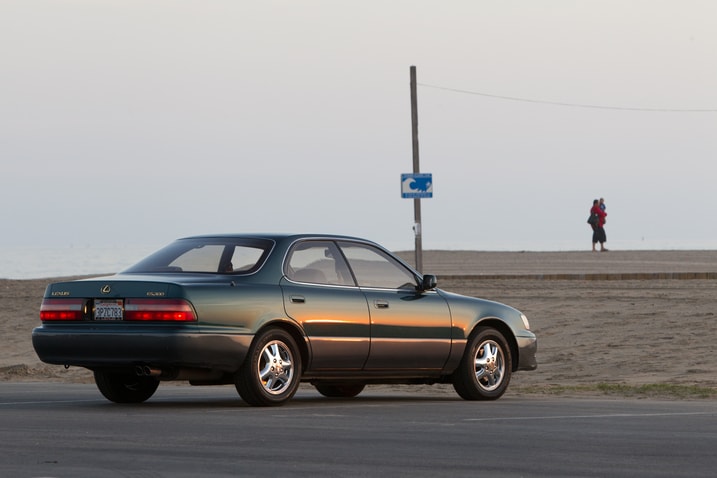
A friend of mine is staging a big car show on top of the remote hill above Ortega Canyon Road where he lives as a way to raise money for his local fire department, and I'm thinking real hard about taking the 1996 Lexus ES 300.
Really, it's that good. It’s in great condition and expresses its time way better than my plain old Porsche 911. And what are the chances that you’re going to see another one up there?
I might even dust it off before I go.

So as I rolled into the lane between the corrals where they were staging the car show part of the 2012 Hooligan, the parking guy looked twice at the 1996 Lexus ES 300 and inquired if I’d be entering the show.
“Of course,” I replied. “It’s a priceless piece of Americana.” And after I thought about it for a second, I realized that this is more than just blather, because this cheap and cheerful ES 300 really is a car with a story to tell.

About 1996, the car industry had finally recovered from the big business bust at the end of the Reagan years that made sports cars disappear from the streets and nearly put Porsche out of business. The Japanese premium brands had all appeared and they proved enormously influential, changing car design both in the U.S. and in Europe (even though executives in both places naturally denied it). Lexus seemed to resonate the most with Americans, and in this Lexus ES 300, you can see why.
The Lexus ES 300 is meant to be perfect transportation, a refined, reliable and unobtrusive means of getting from here to there. It’s dressed up in the fashion of the 1990s – an elegant form, high-quality paint, the two-tone treatment that has been part of American automotive style since the 1920s, the glitzy self-indulgence of gold trim, and the flashy chrome-finish wheels that dominated the 1990s.
Even the cabin is an aesthetic marvel – the warm tones of the wood trim, the techno-trickery of the electroluminescent instrument display, the modestly bolstered chair-like seats, the wears-like-iron leather upholstery, and a steering wheel without control buttons.
This is simple transportation that has been executed according to a very high standard of quality, and it's interesting that this is what made the car appealing then as a luxury device and still makes it appealing now as a used car.
Surprisingly enough, this line of patter worked on almost everyone who passed by the ES 300. No one thought twice to see it parked next to a Corvette C2 or a Triumph TR-4 or the phalanx of Fiat 500s across the road, or even the street-legal Can-Am replicar.
Of course, the prize of the day went to a clone of an early-1970s Porsche 911 RS and not to us, but the Lexus got noticed. We were chatting about it with someone and actually never mentioned the name of Edmunds when a tall, spindly young guy with a floppy hat and shorts pipes up, “The ES 300 from Inside Line?! I read the site every day! Love that car!” So apparently this Lexus is famous.
There were about 200 cars at my pal’s event, and he and his neighbors raised about $3,500 for their volunteer fire department. We’re going back next year. This Lexus ES 300 might just be a used car, but it still tells a story about the things that every American wants in a car, whether it’s new or used.

After a long weekend with the Lexus ES 300, I put the key down on Mike Schmidt’s desk and told him, “This is the world’s best commute car.”
And it totally is.

Easy to slide into and out of the driver seat. A driving position that’s big enough to spread out and an expansive view through the windshield. Accelerates smoothly if not quickly, and the transmission is meant to enhance the whole smoothness thing with unobtrusive shifts and a relaxed (and probably imperfectly efficient) calibration for the engagement of the torque convertor, predictable brakes, soft suspension rates, and steady and deliberate driving dynamics.
I never once thought twice about it. Not when I drove it to the grocery store. Not when I climbed a 2,000-foot ridge on a narrow 3-mile road to visit a friend’s house, nor when I braked the car though the two dozen corners on the way down again. Not when I accelerated into freeway commute traffic, not when I jumped on the brakes in freeway commute traffic. And not when I drove 70 miles on the San Diego Freeway with the a/c blasting at full force (it did pretty well for a car of this vintage, really), on a day when the dashboard readout for the outside temperature registered 102 deg F.
In fact, I never had to think about the car at all. This is a testament both to the inherent goodness of the car as a piece of transportation technology and also to its present state of repair, when all major issues have been addressed and its service needs have been optimized.
This might be just a cheap used car. But when I’m driving it, I never think of it as cheap or used. To have so much for an investment of so little makes this Lexus ES 300 the most perfect device for a day in Los Angeles commute traffic that I can think of.

My favorite part about driving our long-term 1996 Lexus ES300 is how easy it is to hang my elbow out the window. This low beltline, combined with the Lexus' thin A-pillars, make for a very open-feel driving experience. It may seem trivial, but in this era of rising beltlines in cars, it's a sense that's getting harder and harder to duplicate. Many cars these days make you feel as though you are riding in a bathtub.
For some, that high-beltline "bathtub" design is actually a desirable feature. Consumers like all that metal surrounding them, said a Cadillac design executive in a 2010 AARP article, "They feel safer, even if that isn't necessarily the case."
In the same article, a Ford safety director pointed out that the high beltline on a 2011 Ford Taurus was one of its most attractive features. Not to me.
Still, some exterior features, such as larger A-pillars, do help strengthen the car in an accident. The ironic part is that they also reduce visibility.
What do you think of cars with high beltlines?

We bought this car to see if a $3,500 car could provide reliable transportation. The only measure of success is whether it is still running and safe to drive. As we consider each repair, we try to imagine a family on a really tight budget. So if it has a slow oil leak would our imaginary family pop for the $350 repair? Or would they just top it off now and then.
But now we have a big decision and we need your help. The fun of the project, for us, is the support and suggestions from you guys, the readers. So here's what's keeping us up at night.
Our ES is closing in on 150k miles and the big service visit that brings. For other Edmunds.com long-term test cars, we would simply whip out the manual and do whatever it said. With these near-new test cars, we expect them to last forever. With 150k on this old guy, "forever" is almost here. Some would say forever has already come and gone.
Here's what's needed:
• Replace engine oil and oil filter
• Replace engine air filter
• Replace engine coolant
• Replace brake fluid
• Replace air conditioner filter
Then, of course, there is a laundry list of inspections to perform, the repair of each which will likely bring a hefty price tag. For an idea of what it would cost, we checked the 150K service in our Car Maintenance section and it came up with $214. Experience has taught us that a Lexus dealership would charge much more.
So, are we really going to do everything in the manual? Or do we just do the oil change, tire rotation and tell the mechanic to let us know about anything that will, "Stop the car from running?"
And, as you frame your response, think of that family on a tight budget. Like a lot of folks these days, they're really having trouble making ends meet.

The sixth chapter of our Debt-Free Car Project is now live. It is a summary of what has happened over the past few months and tallies up the repair expenses. Is the Lexus living up to its "Debt-Free Car" nickname? Follow the link below to find out.
The Debt-Free Car Project Chapter 6: Midyear Check-In

A couple days ago we noticed that the pressure was pretty low for our ES 300's driver-side front tire. At first we thought we had a slow leak, perhaps from a puncture. But after not seeing any visible indications of such, we took the ES over to our tire place of choice (Stokes) and had them take a look.
Turns out some of the chrome plating had worn off from the inner part of the wheel, creating some corrosion. That in turn was slowly letting out air at the tire bead. Stokes used a wire brush to remove the corrosion and then applied some bead sealer. They say it sealer might last six weeks, or it might last a year. But the only permanent solution would be to re-chrome the wheel or buy another one.
Total repair cost was $35.00.

We've already put a lot of highway miles on our ES 300 — most notably, Phil's cross-country trip. And after after a recent (and much shorter) five-hour highway trip, I'd agree with his sentiments. Our ES is a solid cruiser. It's pretty quiet, it's easy to see out of, there's sufficient V6 power and the front seats are comfortable enough. And as a nice change of pace, I actually enjoyed being unplugged in the sense of not having Bluetooth or auxiliary/USB hookups. I listened to some terrestrial radio here and there, but for the most part it was just me and my thoughts.
The ES may be the doormat of our long-term fleet, but so far I'm enjoying it nonetheless.


Our Lexus ES 300 has cleared 150,000 miles. It seems to be running pretty strong.

When we bought Thy Olden Lexus, it had 135,000 miles on it. You can read a summary about our experiences so far in Ron's Midyear Check-In article.

It seems I neglected to "knock on wood" on the ES' wood trim yesterday after writing that it "seems to be running strong." And now I get punished by the irony gods. The ES is out of commission, marooned in the parking lot of my daughter's elementary school.
The situation: I drove to the school for afternoon pickup. Park, get the kid, come back to the car. Couldn't have been more than 3 minutes expired. Get buckled up. Turn the key. Nothing. Hmm. No turnover, no "click-click-click" sound. Just one "click." The car's accessories are working, though. Try a few more times. Same result.
Dying battery? That's my first guess. But it seems strange since the car's been starting fine and was just running a few minutes ago. Natural guy reaction: I pop the hood to take a look. Of course there's little reason to do this. I have no tools, no jumper cables and have no idea what to look for other than loose battery cables. If only a gremlin would pop out, laugh manically and then run away.
Naturally, being school pick up time, there are other parents pulling into the lot and getting their kids. One particularly good looking mom sees me standing in front of the ES with the hood open. "Need a jump?" she asks. I'm a bit flummoxed. The distressed, saved by the damsel. Yes, I say. I also mumble something about the ES not being my car, suddenly not feeling the love for the green, gold-packaged ES. She says she has her husband's truck, and it might have cables. She goes off to check. Meanwhile, my daughter is asking: "What's wrong, daddy?" So I get to tell her about cars and batteries.
Hot mom comes back. No luck on the cables. She apologizes. So plan B. I call a friend who's not too far away. "Come help me with this car," I ask. He knows what I'm driving. "About time, new car Romans," he says. "Where's your super awesome BRZ now?"
So my daughter and I wait around about 30 minutes until he arrives with some cables. We get everything hooked up. Turn the ES' key and ... nothing. Same problem. Oy. So it's not the battery. Maybe it's the starter. Or maybe the battery is just super dead because of a bad alternator. Or maybe it's the flux capacitor.
Anyway, we abandon the ES in the school lot so I can get my daughter home. I'm going back now, maybe to fix it, probably to get it towed. Whee. More on this tomorrow.

Thy Olden Lexus — it lives! Sort of. Maybe "it's in critical condition" would be more apt. After writing yesterday's post about how the ES wouldn't start in a school parking lot, I got a lift from my house back over to the school to see if I could get the ES to start. Or get it towed.
I had first done some very brief web searches to see if I could come up with possible causes. Nothing definitive turned up. Battery? Starter? The only thing that caught my eye for a possible temporary fix was that there was a "bound starter" and hitting the starter with a hammer might help. Percussive maintenance? I'm in!
Well, I tried that. The starter was hard to get to. And hitting it made no difference. The ES was still not turning over, with just one click in terms of sound yet with the accessories still working. So at that point it was quite late in the afternoon, so I called for a tow truck.
I had to wait about 40 minutes. Meanwhile, I listened to NPR on the ES' radio. Joe the driver pulled up and asked me a few questions. He asked if he could try starting it. Sure dude. At first it's the same thing for him. But then he quickly cycled the ignition key on and off about 10 times. About the 10th time the engine coughed and turned over a little. A couple more tries and it started. I was both dumbfounded and impressed.
Joe said he thought it was the battery and that maybe there was just barely enough power left to get it to start. The best part was that he didn't even charge for the service call.
So I drove the ES back to my house without any issues. I tried starting it once more, and it fired up. Thinking all might be OK, or at least temporarily, I hooked up my battery tender to the battery. It ended up charging the battery for a couple hours. Hmm. If the battery were really dead, it'd likely take more than a couple hours worth of charge, even though it did get some charge time when driving. So I was still perplexed.
This was all yesterday afternoon/evening. Finally this morning I tried it again. The ES started. But ... now it dies immediately at idle after starting. Keeping my foot on the throttle is the only way to keep the ES from stalling. This is the starting problem that we encountered before, when we eventually replaced the mass airflow sensor.
The good news at least is that the ES is safe at my house. I've scheduled a service appointment at an independent repair shop for Monday morning. My plan at this point is to drive it/nurse it over there.

I took our Lexus ES 300 in for service this morning to a local independent repair shop to address the car's engine issues. To be honest, the no-start problem has not reoccurred since that initial time, though I still had some die-at-idle this morning while the engine was cold.
Ron Montoya and I picked out the shop based primarily on the its Yelp reviews. The shop's owner seemed pretty familiar with our car's problems, so my initial feeling is that it's in good hands. I'll know more late today.

The ES 300 is fixed, and the no-start mystery has been solved: the problem turned out to be the starter solenoid contacts, which were worn and corroded. (If that's what you guessed from my prior posts, pat yourself on your back.)
According to the mechanic at the independent repair shop I took the car to, this is a fairly common Toyota problem for cars of this vintage. Back in the day, he said Toyota used to force you to purchase a whole new starter motor, but now you can just get the contacts separately. The mechanic even had a bag of the little copper contact pieces on his bench, so I'm guessing ours isn't an isolated case.
The mechanic also cleaned up the ES' throttle body, which he said had heavy carbon build up on the throttle plate and bore. This was likely a cause for the subsequent die-at-idle issue. The idle control valve could still be the root of the problem, but he said it seemed OK at this time.
The new starter contacts were $14.65. With labor and tax, our final bill came to $136.72.

This is something that you might relate to: pretty much every time I get into our Lexus ES 300, it reminds me of driving older cars that have been in my family through the years. The ES is like that car your parents/uncle/grandma bought years ago, and it's still around. Maybe you no longer live where you grew up, so you fly in to visit for the holidays. And there it is, the used car in the family that's still kicking and yours to drive during your stay since you didn't get a rental car.
Our ES is like that for me. The seats are worn, the steering wheel wrap is slick and the radio antenna sounds like it's got one foot in the coffin when it powers up and down. This car's done its time. But no-starting issues from last week notwithstanding and knocking on fake wood, the ES does again seem to be running pretty well, and there's a sense of comfortable familiarity here that I sort of enjoy.

In an earlier ES post, a commenter noted that our gauges were looking pretty bad. And true enough, they are.
Actually, I think they've gotten worse since we bought the car. Carroll took an earlier picture of them, and while the needles were always flickering/burned out in that picture and video, it seems the number illumination was fine. But now we've lost illumination for part of the speedometer. It's not a huge problem, but it can be annoying not being able to easily tell what speed you're going. (And in daylight, it's actually worse than the above photo would seem to indicate.)
Ron Montoya's done some basic research. The fix entails pulling out the gauge cluster, disassembling it, and installing new bulbs. It looks like we've lost two bulbs so far. (And while we'd be at it, we probably just replace all of them.) Alternately, we can pull out the cluster and ship it to a guy in Wisconsin who repairs them for $99. He can also put in LED bulbs if you want, and will also fix the needles.
We haven't decided what to do yet.
The other thing possibly needing attention: our ES has got a couple leaks (oil, I think). Not terrible, and not unexpected for a car of this age. But it's also something it might be worth checking out during its upcoming 150,000-mile service.

(Pictured: about two week's worth of drips)

Take a dip in our hot tub time machine: our ES 300 has no more than an old-school four-speed automatic transmission. But it does have an old-school cable-actuated throttle, too. The ES responds in a nice, linear fashion to throttle inputs. Push a little, get a little. Push more, get more. There's no electronic trickery here by the automaker to tease out another 0.5 mpg by making things sluggish. Nor does the transmission upshift to top gear at the earliest opportunity.
It's throttle tuning back when gasoline was $1.86 a gallon (adjusted for inflation). It's quite nice, actually.

"I'd never buy gas at --" fill in the blank. Yes, we've all heard this from friends and family from time to time. So we decided to set up an informal test. For the past month we've filled our 1996 Lexus ES300 on 87 octane gasoline from so-called off-brand gas stations. We wanted to see if there was a drop off in performance or fuel economy. Next month we will only fill it with 87 octane from the big boys, those companies that say their gas is better because it contains a secret sauce with a high-tech name.
This month we got an average of 23.9 mpg over almost 1,000 miles. The previous month, running 91 octane we got 24.9 mpg over 1,800 miles. Yes, we know, we're mixing apples and oranges (or, in this case, regular vs. premium). And then there are different driving styles and conditions to account for the variation.
Anyone out there think there is a difference between the gas from indies and the majors? Or is it, as a friend cynically suggested, "all just marketing."

I noticed something different about our old Lexus ES 300 when I started merging into traffic the other day.
What was it?
I could easily see out of it.
The A- and B-pillars are very slim by current standards, making the front and side views positively airy. The C-pillar is also reasonably narrow, while the semi-wraparound rear window is huge.
I'm not going to say it's as structurally safe as today's cars. But damn, there's something to be said for being able to easily see the cars around you.

We asked your opinion and you gave it to us: how should we handle the 150K service visit? Our dilemma is that, with a car this old, we're not going to do everything the manual recommends. So what's really important to do?
The general consensus, which we agreed with, was this: find a mechanic you trust, get him to give you a list of necessary work, and then prioritize. That's what we did. And here's what happened.
We took the ES to Overseas Garage, in Long Beach, Calif., which is highly recommended on Yelp. We told Andy that the car was due for the 150,000-mile service but we didn't want to do everything the manual recommends. His expression was somewhat blank as if he wasn't real concerned about what was in the manual. The cars he deals with are basically, off the charts.
We told him to give us an oil change and tire rotation and give the car a look-over. We added that other mechanics told us we have an oil leak. Again, the blank stare. But a few hours later we got a call from Andy. "Okay," he said, and sighs heavily. He tells me there is an oil leak around the timing belt cover. And if you take off the timing belt cover, you might as well do the timing belt. And if you do the timing belt you might as well do the cam seals and the water pump. Bottom line: $798.
Well, as Andy says, the leak "isn't gushing." In fact, we don't even see oil drips under the car. Occasionally we get an oil smell in the cabin but it mixes with various other old, musky, funky smells. And another mechanic told us the timing belt looks good. So we are tabling a decision on this repair as the money in our repair budget adds up. Remember, we are putting ourselves in the place of a family who needs cheap transportation but owns the car outright. Our fictional family budgets $365 a month – the typical amount for a used car down payment — for repairs. Now, after spending $75 for our oil change and tire rotation, we have $629.
By the way, Lexus is cutting us loose into uncharted territory. The 150K service is the last in the owner's manual. From now on, we'll have a blank look on our faces when anyone refers to the owner's manual.

Trundling down the San Diego Freeway at 30 mph, a Volvo Amazon 122S coasted by in the other lane. One of thousands built between 1956 and 1970, it actually looked just like the car in this factory photo — it was even red. It made me think that this Lexus is the Amazon reborn, the kind of car that just seems to keep going almost despite itself.
Volvo guys are always showing you the odometer of their cars, maybe because of Irv Gordon, that guy on Long Island who has nearly 3 million miles on his 1966 Volvo P1800S. Volvo guys take pride in driving old, worn cars, and Volvo in fact keeps track of those owners who reach the million mile mark.
There's always a kind of debate whether old Volvos like the Amazon are genuine classics or just old cars. Personally I think anything with a lot of miles is a classic, and I can totally see the Lexus as this sort of car.
The problem for million-mile longevity will of course be the electronics. As we've discussed before, it's easy to keep things like mechanical fuel pumps going. But what are we going to do when the ES 300's electro-luminescent instrument display finally flickers and goes completely dark, as it threatens to do every time I drive it?

Good thing the roads in California are lined with reflective markers, because otherwise I might have driven the Lexus ES 300 into the ocean last night.
I'm not saying the headlights are weak, but the last time I saw a light pattern like this, I was riding an ISDT-style Husqvarna dirt bike with a headlight the size of a baseball. If you wanted more light, you just revved the engine harder.
The Rontoya tells me that the Lexus had its headlight lenses cleared with a Mequiars kit about six months ago, but it seems like the plastic has become occluded again. Maybe another treatment is required? Or maybe the bulbs are toasted? Or the little electron running around inside the ES have grown feeble?
Probably you wouldn't notice the headlights while driving around in the city, since there are plenty of other cars to light the road around you, not to mention streetlights. But when it gets fully dark, the difference between the Lexus' headlights and new cars is dramatic.
We'll look into it. Probably we'll be polishing the plastic again.

Drove the ES 300 to Buttonwillow Raceway Park for the annual Mazdaspeed competition, in which Mazda awards a season in the Playboy Mazda MX-5 Cup to an amateur racer.
It was 300 miles there and back, and the Lexus made the long pull up the six-percent grade in the Grapevine pretty effortlessly to the top of Tejon Pass at 4,100 feet.
I took it easy on the car by not putting a heavy load on the engine with large throttle inputs, yet the car still cruised up the hill at 70 mph without a problem. No crawling up the pass in the slow lane with the trucks.
You'd think that there would be some shame associated with bringing an old used car to the race track, but instead the racers got the idea of this car right away. Any real racer spends all his money on his race car, so his street car is usually something that qualifies as simple transportation.
In fact, one Mazda guy said, "Hey, I did the same thing. Got an old 1980s Mazda MX-6 for $1,800. Still running, and maybe the smartest car purchase I ever made."

With the shorter days and the rainy weather, we've been feeling in the dark with our 1996 Lexus ES 300. Michael Jordan diagnosed the condition as "cataracts" and got a lot of great comments about bulbs vs. cleaning the lens. We're going to do both. But we decided to pop for some new headlight bulbs. These X-treme Power bulbs from Philips come highly recommended by readers and other users on Amazon.com where we ordered them for $28. If they really are 80 percent brighter, maybe we won't have to scrub the lens.
We will report back after we install them.

I was getting ready to put the Philips X-treme Power headlight bulbs into our 1996 Lexus ES 300 when I had a chance to take this picture. I parked the ES (left) next to Mark Holthoff's 1999 Mercedes-Benz CL500 with xenon headlights. The difference is pretty obvious. The ES's lights are yellowed while the Benz throws a nice clean white light.
Sunday afternoon I popped the new bulbs in with high hopes to rival Mark's beams. Here's what happened.
First of all, I discovered one of the ES's high beams was burned out so I had to run down to the local auto parts story where I bought Sylvania Silver Star for $39 (minus one of those really irritating $15 mail in rebates). Then, I had to take out the battery to gain access to one of the low beam bulbs. But I was done in less than an hour with all four bulbs blazing away.
Next time I get together with Mark I'll shoot an "after" picture. But I did drive the ES back up to the same location and eyeballed the result of the new bulbs. There is no question that they are brighter now but, because of the yellowed headlight lens, they now cast a brighter yellow light. So, as many of the commenters have said, need to clear the headlight lens too. That will be the next DIY project.

Recently, we wrote the ES 300 might need a new timing belt and we would save the $360 a month allotted for repairs until we had enough to pay for the $800 job (timing belt + water pump + cam seals). This prompted some comments about the concept of the Debt Free Car in general.
"I am a fan of this project, but the basic premise is false," writes Bankerdanny. "People who are looking for a $3,500 car as a primary driver are almost certainly unable to afford a $360 monthly payment, that's why they are looking for a $3,500 car. So once they buy that car they are not setting aside $360 a month for repairs."
We don't have scientific proof to counter this opinion. But we would like to say that economically challenged people can still be organized. Thinking ahead doesn't cost money. Besides, we aren't saying all people handle car repairs this way. We are suggesting that they do this.
There was once a grand tradition in this country where people "saved up for" the things they wanted. But because of easy money loans, credit cards and aggressive encouragement to buy! buy! buy! that trait seems less common. Let's bring back that tradition and set aside a little money for emergency repairs.
In the meantime, the blogs, and your comments, have been a great opportunity for discussion. Thanks for chiming in, even when you don't agree with us.

I spent a few minutes the other day just admiring the lean silhouette of our Lexus. Muscular curves are all well and good, but there's something classic and elegant about this sedan's more slender, stretched-out approach to design.
Aesthetically, there's just one thing about the car's exterior that bugs me...

...and it's this: its gold badging. Gold just strikes me as being on the garish side. And while I think the car's sheet metal still looks attractive and fairly current, the gold badging is the one aspect of the vehicle's appearance that screams "1990s."
Are you a fan of gold badging?

Every old car is bound to have some type of fluid leaking from it. Our 1996 Lexus ES 300 is no exception. There are two distinct leaks here, the light brown one on the left and the dark red one on the right. I should point out that this didn't happen overnight. This is about nine days of accumulation.
Can you guess the two fluids? For reference, the ES 300 was backed into its space. The driver's side of the car is on the right side of the photo.
The stain on the left is motor oil. We found out about this one some time ago. There is an oil leak in the rear cam seal, near the timing cover.
The stain on the right is power steering fluid. We found out about this recently, after the last oil change. The mechanic noticed that a hose leading from the power steering to the pump was leaking. The leak is near the exhaust manifold. This may explain the smell that occasionally wafts into the cabin.
It would cost us roughly $400 to fix the power-steering fluid problem, and probably another $250 for the oil leak. We're going to pass on these for now. But if the leaks get worse, we may have to take care of them.

There's a funny caption somewhere in this photo, but I won't go there. I swear that I was at this strip mall (no pun intended) on official Edmunds business.
I drove our 1996 Lexus ES 300 up to Saugus, a community that's about 32 miles away from the office. There was a light rain throughout most of the drive and the roads were pretty slick. Here are a few observations on how the Lexus performs in the rain.
Our all-season Kumho tires held up quite well. The car never hydroplaned, even with speeds of up to 70 mph.
The rear windshield could use a coat of Rain X, because the water didn't bead away. It just accumulated and made it hard to see out the back.
The Bosch wipers we bought in March are still in good shape and did a great job of clearing the windshield. But I think the wiper motor may be on its last legs. It seems to struggle to move the blades and squeaks at the low speed or intermittent setting.
The toughest part about driving the Lexus in the rain was dealing with other drivers (people who follow too closely, people without their headlights on, etc.).
Do you have any rainy-day driving pet peeves?

Recently our 1996 Lexus ES 300 joined a convoy of long-term cars that, together, shuttled a small army of journalists to a local track day. Prior to one particular exercise the instructor infromed us, "There's no need for helmets on this one. Go ahead and set them down someplace."
I'm not one to point fingers, so when a nameless cohort walked over to our innocent ES 300 parked nearby and plopped his helmet on the trunk, we laughed. Then we followed suit. But I promise, it was done out of love and appreciation for its elegantly sweeping, but more importantly, flat trunk lid.
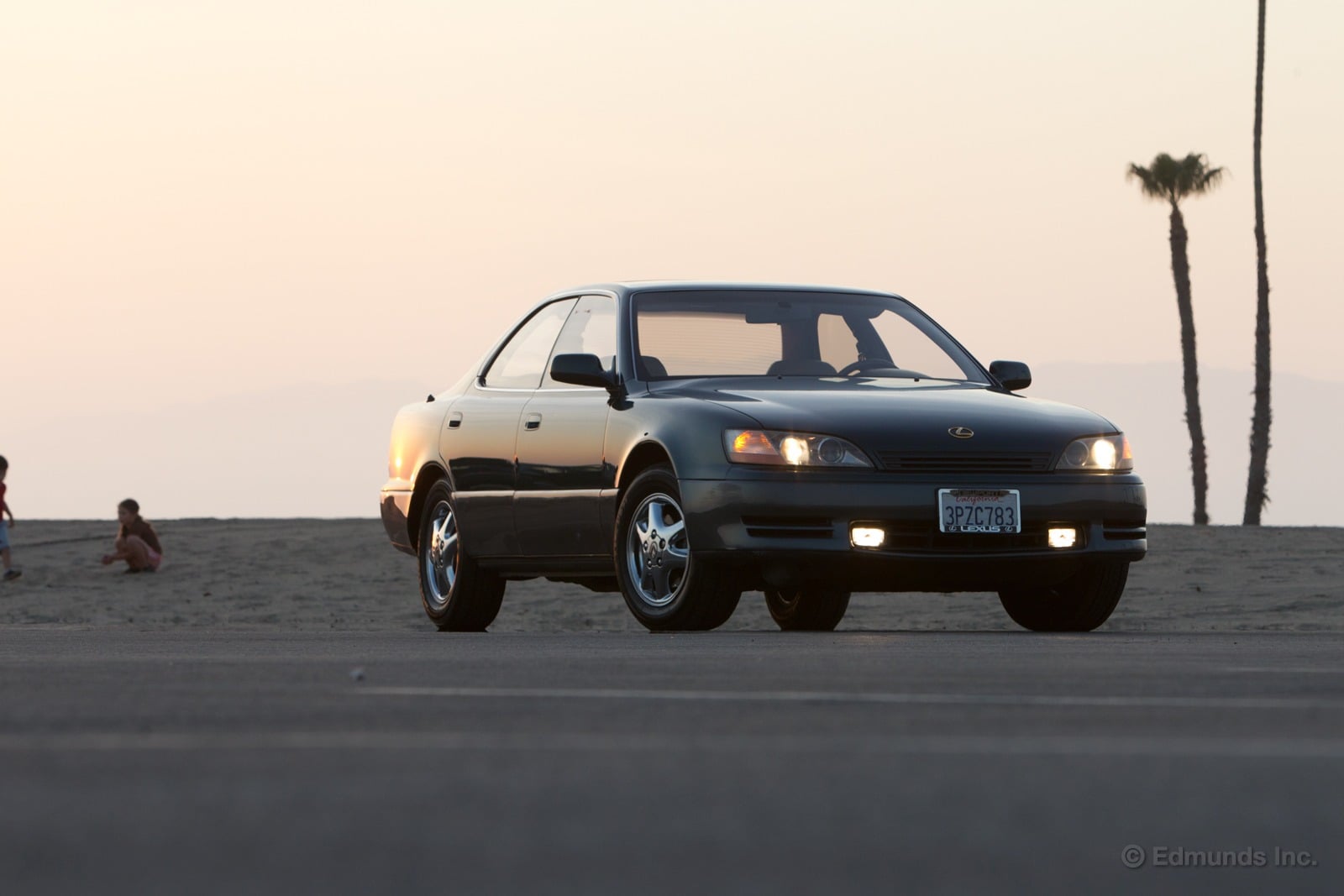
We installed new headlight bulbs in our long-term 1996 Lexus ES 300 last month. The photo above shows the previous bulbs. I have a few impressions and photos of the new bulbs after the jump.
The package of the Philips X-Treme Power bulbs we bought advertised "80 percent more light." After driving the Lexus a few nights, I'm afraid that it doesn't quite deliver on that promise.
It's hardly breaking news when a product doesn't perform as advertised. But still, the lights are an improvement over what they used to be — just not "80 percent" better. I'd guess they are about 25 percent better than the bulbs that came with the car.
Part of the problem is the hazy plastic on the lens. The plastic has oxidized over the years and while we used a Meguiars cleaning kit earlier this year, we may have only slowed down the process.
Some of our readers have suggested taking the headlight apart to give the housing and projector a thorough cleaning. This may be an effective alternative to buying a brand new headlight, but it is far beyond what my DIY skills are capable of. Plus, we're lucky enough to live in a city with plenty of street lights, which can make up for any lighting deficiencies our Lexus may have.
Below are a couple of photos that actually make the light look better than it was in person — most likely because I took the photos from an over the hood perspective. The first image is with the low beams on. The second image is with the low beams and fog lights on, big improvement.
I don't like being that guy that drives around with his fog lights on all the time, but in the Lexus, I may just make an exception.


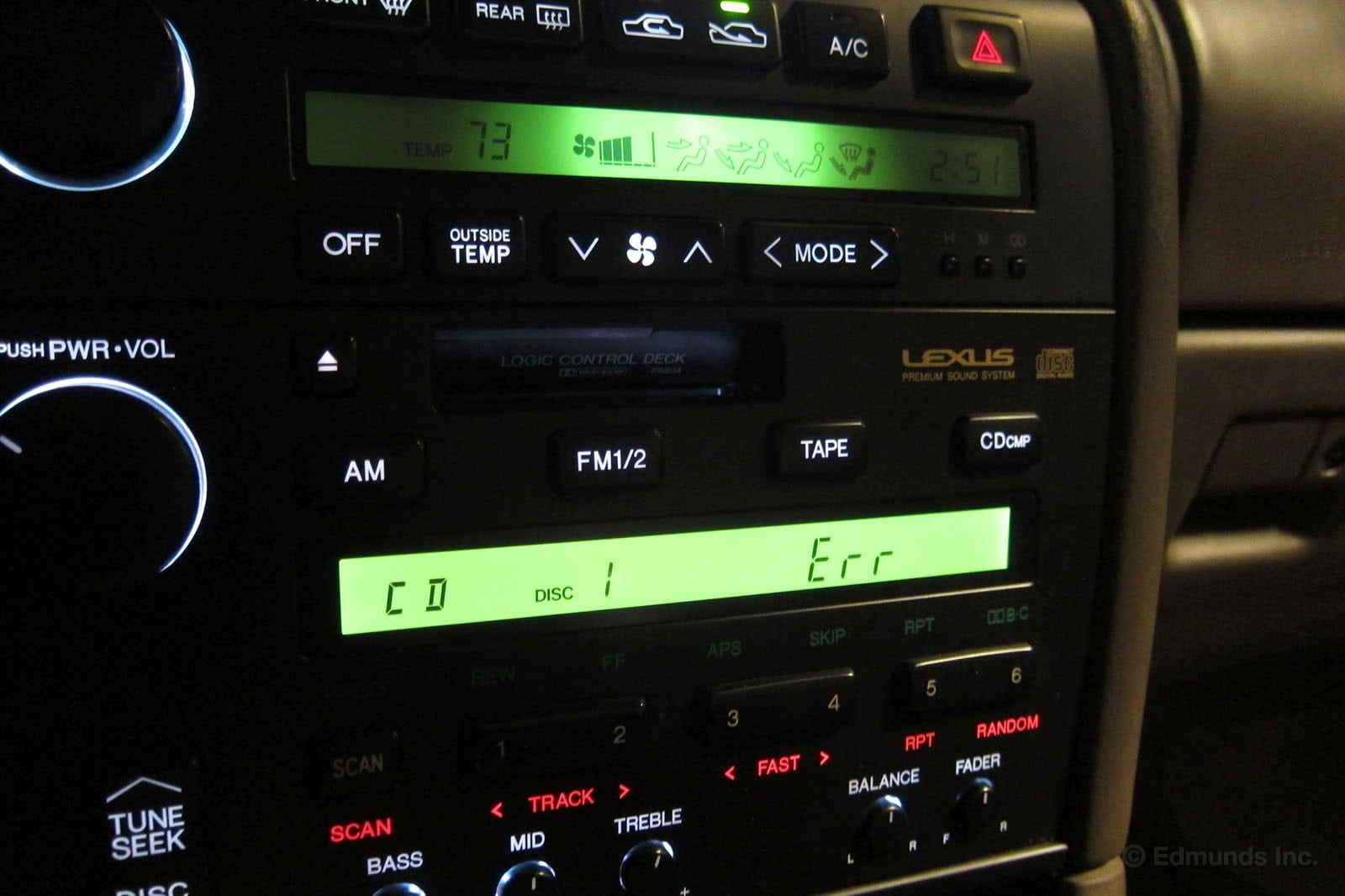
The trunk-mounted CD changer in our 1996 Lexus ES 300 is broken. Well, it's not broken per se, but it doesn't play CDs so it may as well be broken.
Oh, and there's a cassette stuck in that player so it's nothing but silence and the sweet, soothing grinding of a 152,000-mile V6. Terrestrial radio is 100% unacceptable.
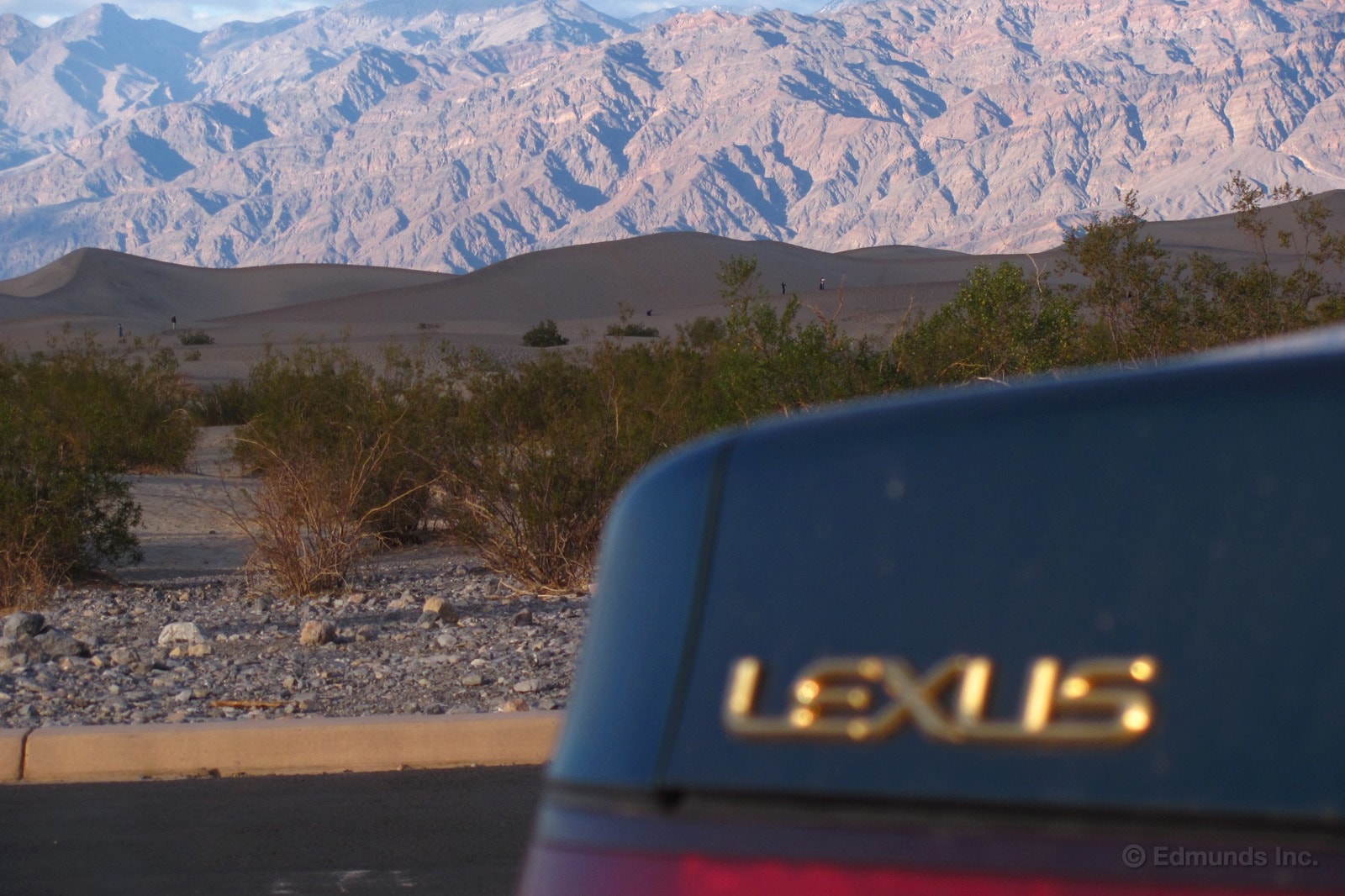
The 1996 Lexus ES 300 is an extremely reliable car. What's most reliable is that it is always down in the garage waiting to be driven. I was supposed to take a vacation road trip to Death Valley in one of our new cars but I was bumped, and wound up in the ES. No problem. We're old friends.
My two sons and I headed out and drove north through driving snow to the little town of Lone Pine, Calif., some 230 miles away. The next morning I came out to find the ES covered in a layer of ice crystals. I fired it up, turned on the defroster and rear window heater and went back inside for a second cup of coffee. When we left for Death Valley, all the glass was clear and the interior was toasty, but our hopes for good fuel economy were destroyed.


In Death Valley, we crept up a 2.5-mile washboard dirt road to the Titus Canyon trailhead. From there we bushwhacked to beautiful Fall Canyon, an easy climb to a "dryfall" (opposite of a waterfall, I guess).
Back in the ES, it was a relief to be back on pavement. We filled up, to the tune of $5.08 a gallon, and headed back home. The late afternoon sun cast beautiful shadows on the rocks around us. The visibility from the greenhouse of the ES is especially good thanks to a skinny C-pillar and the low belt line. Among the car's other strong traits is an exceptionally large trunk which allowed us to just throw in all our junk — no careful packing necessary.
On the open road, the old Lexus is a great cruiser. Don't ask it to turn suddenly or handle unexpected bumps, dips or potholes. It complains when those conditions occur. But turn it loose on a straight open road, and the V6 churns away with no complaints. All told, we added another 723 miles to the rich heritage that is the ES 300.
The second morning I came out to find no ice crystals but a driver's side door that wouldn't open. Couple this with a sudden rattle in the door panel and we probably have a loose or broken part. Maybe we shouldn't have driven on that dirt road after all. We'll repair that back in the big city, along with several other pesky issues.
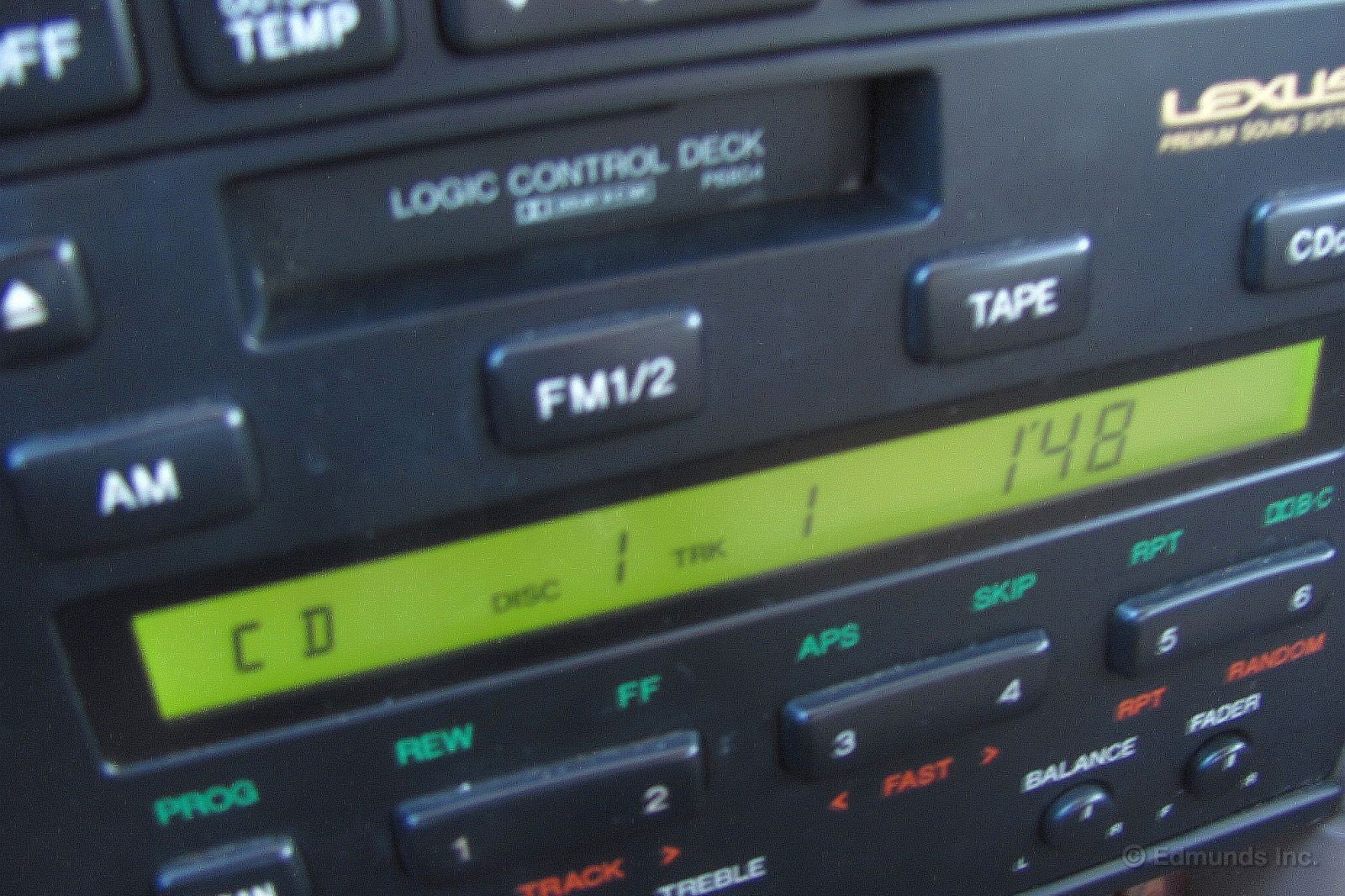
A recent post reported that the CD player in the 1996 Lexus ES 300 was broken. It's not. The problem was that you have to put the CDs into the cartridge upside down or an error message is reported. I know because I've made that mistake before.
I wanted to make absolutely sure it was working so I grabbed the first disc from my stack of CDs that are busy gathering dust. I took it out to the car and put it in (upside down, as I already mentioned) and hit play. The Fab Four were soon amazing me with one of their best albums.
I moved on to the "jammed" cassette tape issue, also reported in the earlier post. I pushed play, then eject, and it finally both played and ejected. So we're completely back up to speed sound-system-wise.
There are plenty of things on the ES that could either be fixed or improved, so it's important to eliminate those things that aren't in fact broken.
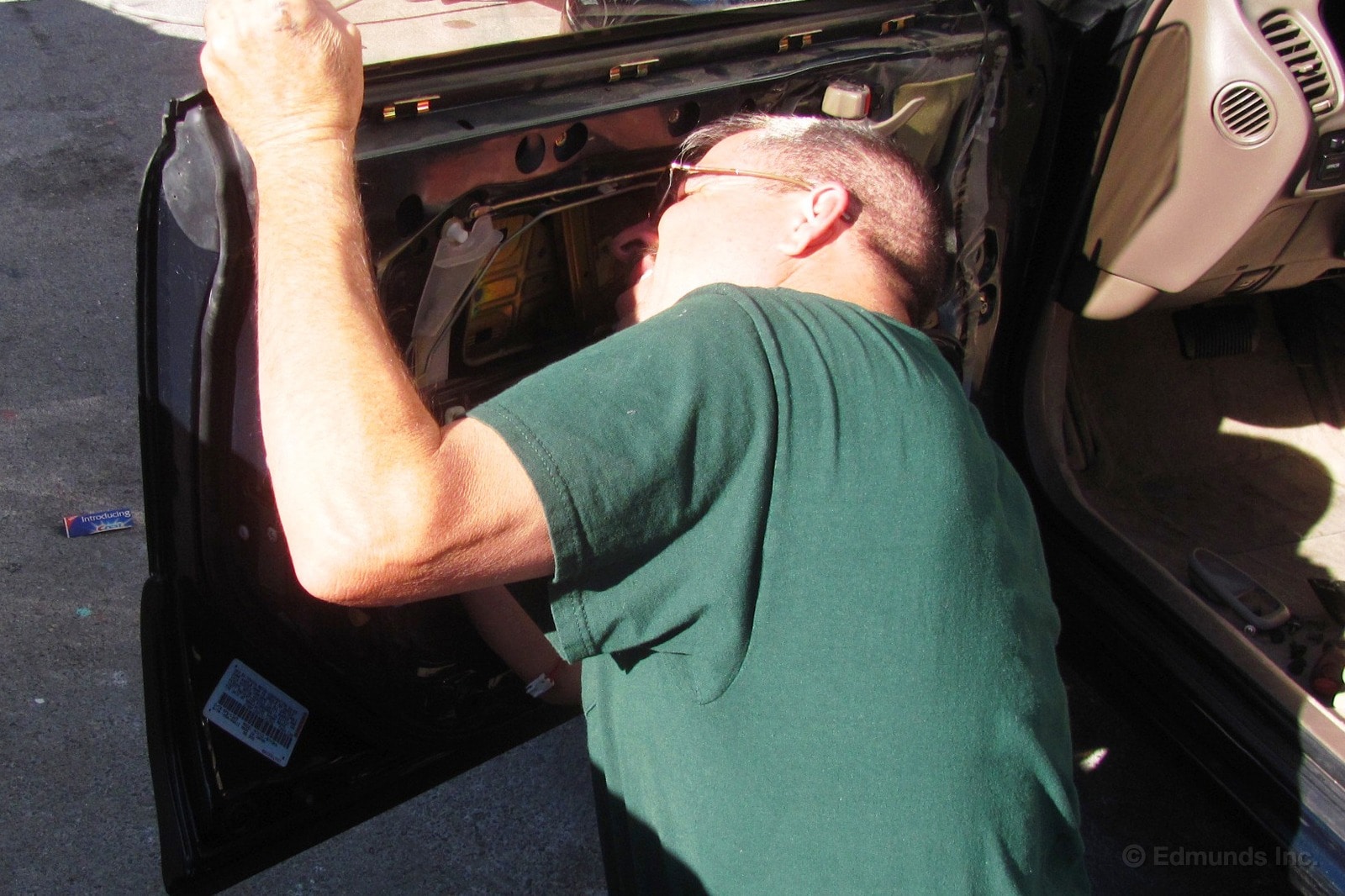
If you're going to own an old car like our 1996 Lexus ES 300 you better have a reliable network of repair experts. We have met some great mechanics while handling our ES problems, such as the broken driver's side door handle.
To recap, on a recent trip to Death Valley, where we took the ES off road, the driver's side door wouldn't open from the outside and there was a nasty rattle inside the door panel. My first response was to nuke the latch mechanism with WD-40. When this produced no result, I shifted gears, so to speak, and watched YouTube videos of other people fixing their doors. It looked really complicated. So I took the car to Burke's Auto Body, in Long Beach, Calif.
At Burke's I met Manuel who frowned at the door and said, "Give me 30 minutes."
I said, "I work for Edmunds.com, an automotive web site. Can I take pictures while you fix it?"
He said, "Take pictures." You see, Manuel is a man of action.
In less time than it takes to write this, Manuel had the door panel off and he was performing all kinds of machinations with the door glass and interior mechanism. He reached inside the door panel and took out a small, yellow, plastic clip.
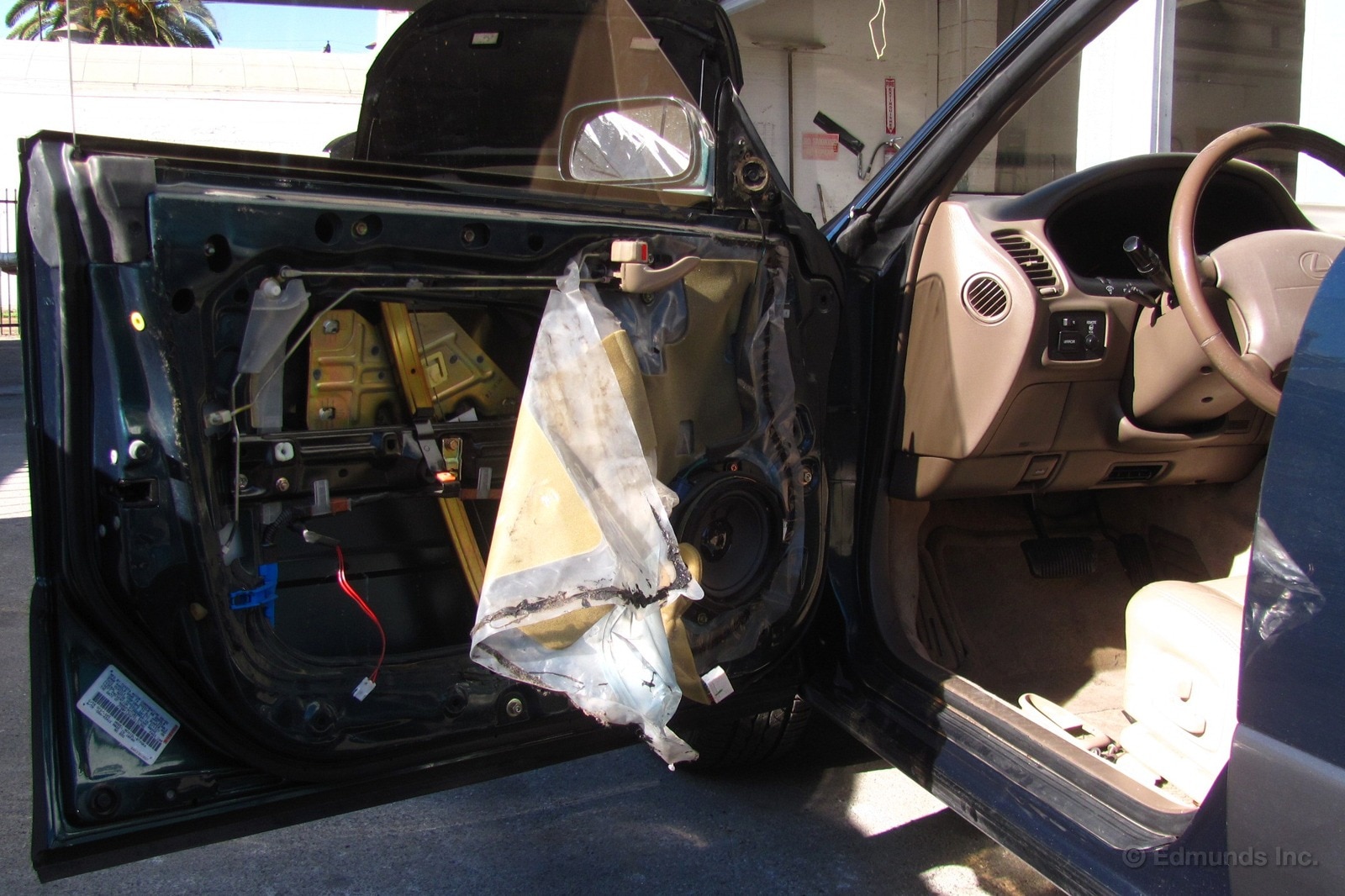
"It broke," he said holding it out.
"Can you fix it?" I asked.
"No problem," he said.
I can't think of any situation where "no problem" would be a bad answer. But after a brief phone call by the office manager, Gloria, she had a worried look on her face.
"It will be $100, parts and labor," she said, and cringed as if I might yell at her.
"That's very reasonable," I said. But inside I was jumping for joy. From all the work Manuel was doing, it should have been way more. Or, just for fun, think of what a dealer would charge. Better yet, don't think of that.
When I went back a few hours later to pick up the car, Gloria was busy with another customer. So I followed the sound of an air wrench and found Manuel back in the shop under a '65 VW Bug.
"Hey Manuel," I said.
He rolled out and squinted at me.
"Thanks for fixing the door handle."
He squinted some more. I don't think he remembered our long conversation from the morning.
"The door handle on the Lexus. Thanks."
"No problem." He went back to work.
When I got home I told my wife about the whole deal.
"How much did it cost?" she asked.
"A hundred bucks," I said.
"Beats a car payment."
I didn't respond. But I was thinking that that was such a cool thing to say.
If you've read this far, make sure you read the next part too. Because here is my sage advice. If you find someone who is willing to fix your old car, and they are honest and reliable, treat them like the most important person in the whole world. Pay without complaint and thank them profusely. Frequently ask them if they've lost weight. Laugh at their jokes. This is all because of this one sad fact: You need them much more than they need you. They already have plenty of customers.
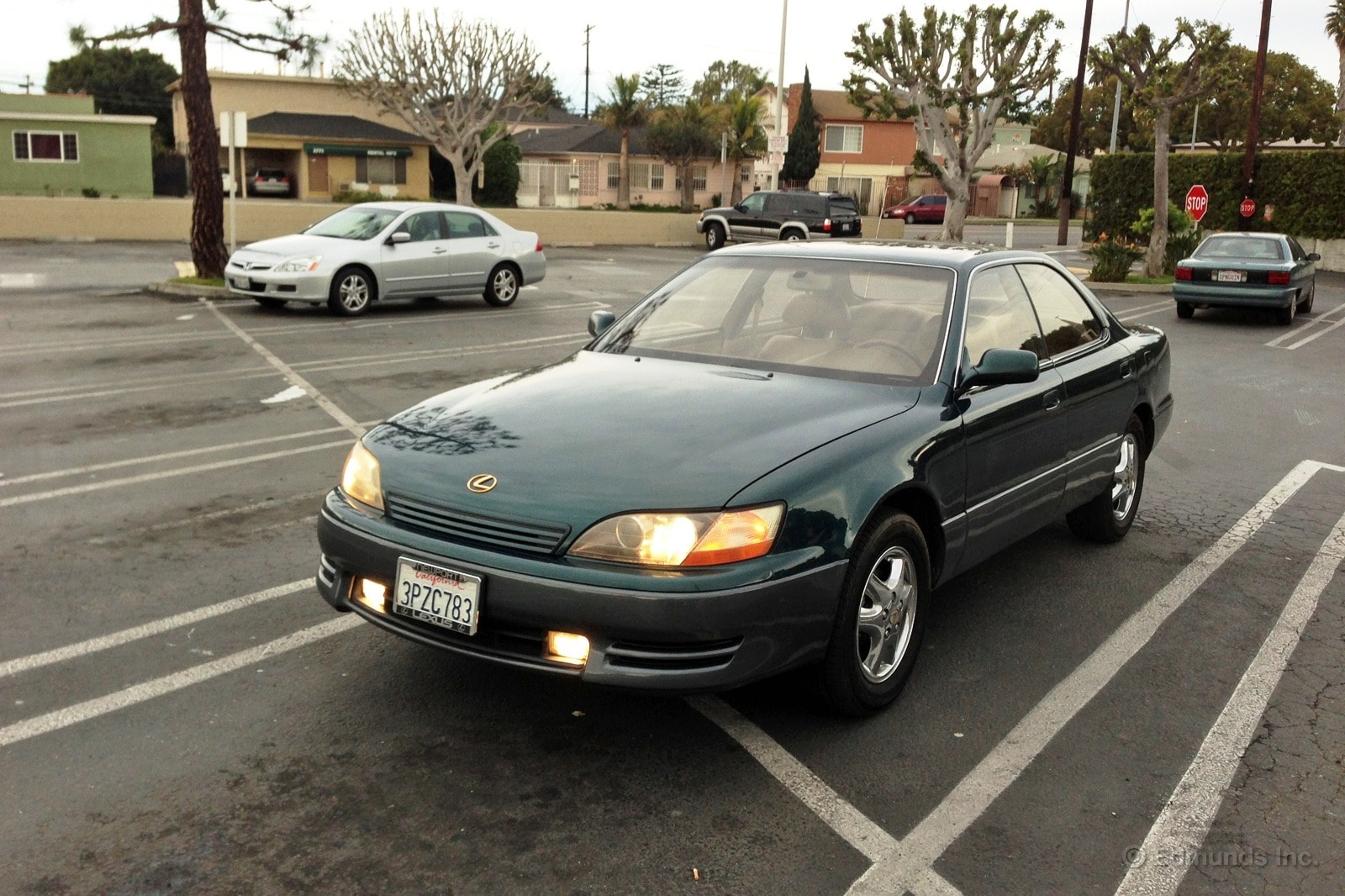
We heard that our long-term 1996 Lexus ES 300 had trouble starting one afternoon, and since Phil and I have become the go-to guys for all ES 300 issues, we went to take a closer look. A colleague told us that the Lexus' engine cranked, but wouldn't hold an idle and would consequently shut off.
Phil tried starting it himself, but he pressed on the gas pedal to keep the rpm high enough to prevent the car from stalling. He held the pedal for a few seconds and when he let go, the engine idled normally. I took the car out to lunch later that day and it started without issue.
"Things seem to be fine for now," I said to myself. "I'll check back on it next week."
No one took the car over the long weekend, meaning that it sat for three days. I started it up by using the "trick," stepping on the gas pedal immediately after turning the key. It worked fine. I drove it home that evening without any issue at all.
But I realized I should try to duplicate the problem for a mechanic so that we can get the problem taken care of permanently. After all, we thought we had this sorted with the repair in Fresno.
The following morning, the Lexus started normally. Of course. At this point, the best we can do is wait until the rough idle occurs again and then take it in for service.
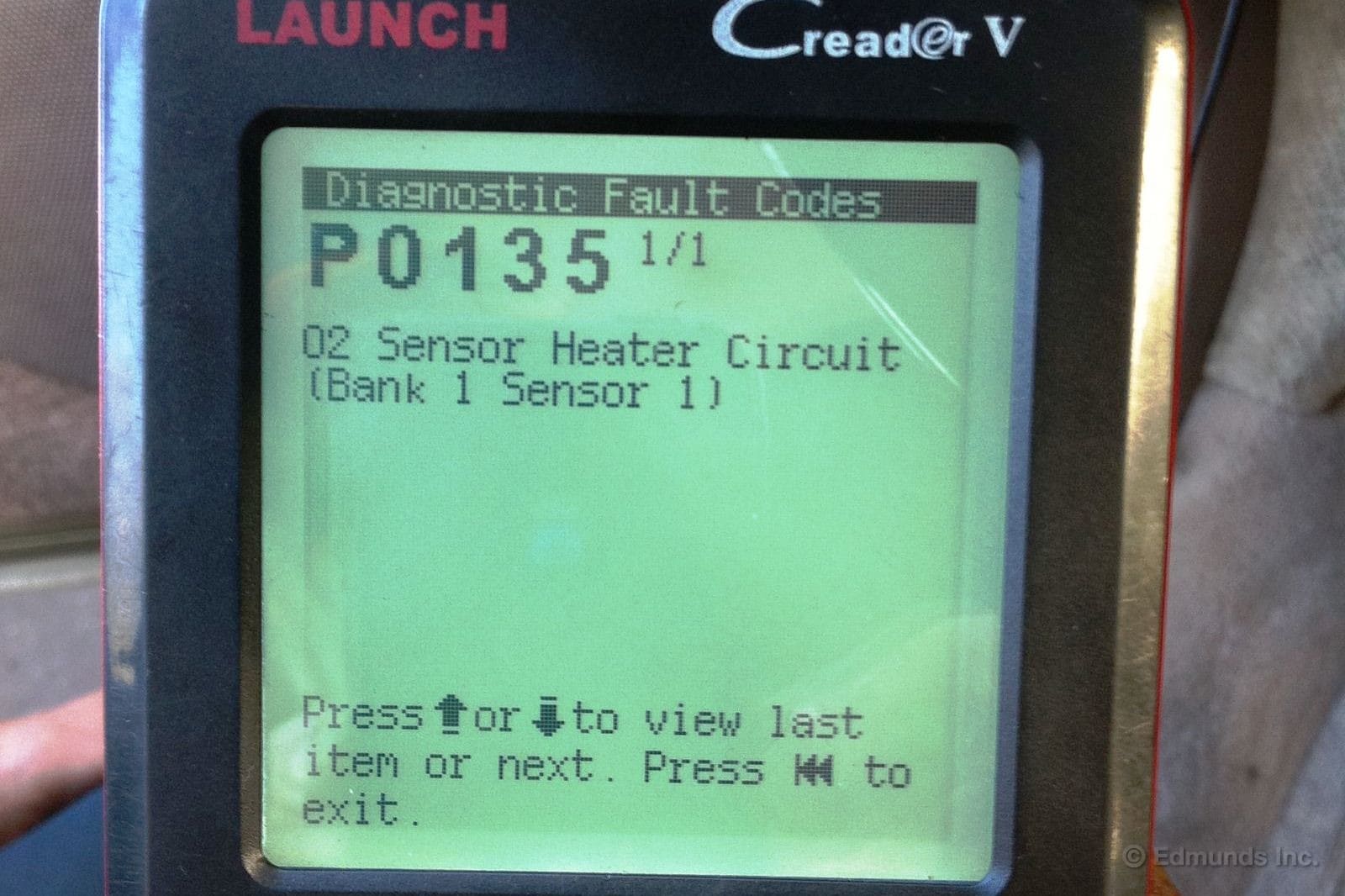
On a road trip to Death Valley, the dreaded check engine light (CEL) came on. When we came back, we took the car to Pep Boys and they read the code for free: P0135, which meant that the oxygen sensor in "bank 1" was malfunctioning. It was surprising to learn that something was wrong with the car, since it still seemed to be running fine.
Even though a car seems to be behaving normally, experts say a faulty oxygen sensor can cut the fuel economy by 40 percent. Sure enough, when we checked our fuel records for the driving we did while the CEL was on, our fuel economy dropped from about 27 mpg to about 24 mpg.
We considered the DIY route to fixing the O2 sensor but after a little researched we learned the faulty sensor was in the rear of the engine and difficult to reach. Instead, we took the Lexus to Overseas Garage, in Long Beach, Calif. There, the mechanic told us that the new sensor would cost $117, plus $144 in labor for a total of $261.
Apparently, the V6 engine in our Lexus, has one sensor in each exhaust manifold and one after the catalytic converter. The sensors simply screw into place, but reaching them can be a problem for do-it-yourselfers. Additionally, we learned that, since the exhaust subjects the sensor to extreme heat, it can "seize" or become frozen in place and be tough to unscrew. A new sensor comes with anti-seize compound to apply to the threads, but the compound should never be put on the sensor itself.
While many people opt to simply ignore the CEL, we wanted to do our part to cutting emissions and save money on gas. In the long run, we think we'll come out ahead. Driving back from the garage, it was a relief not to stare at the glowing check engine light. This made us realize that fixing such a problem provides another benefit: peace of mind.
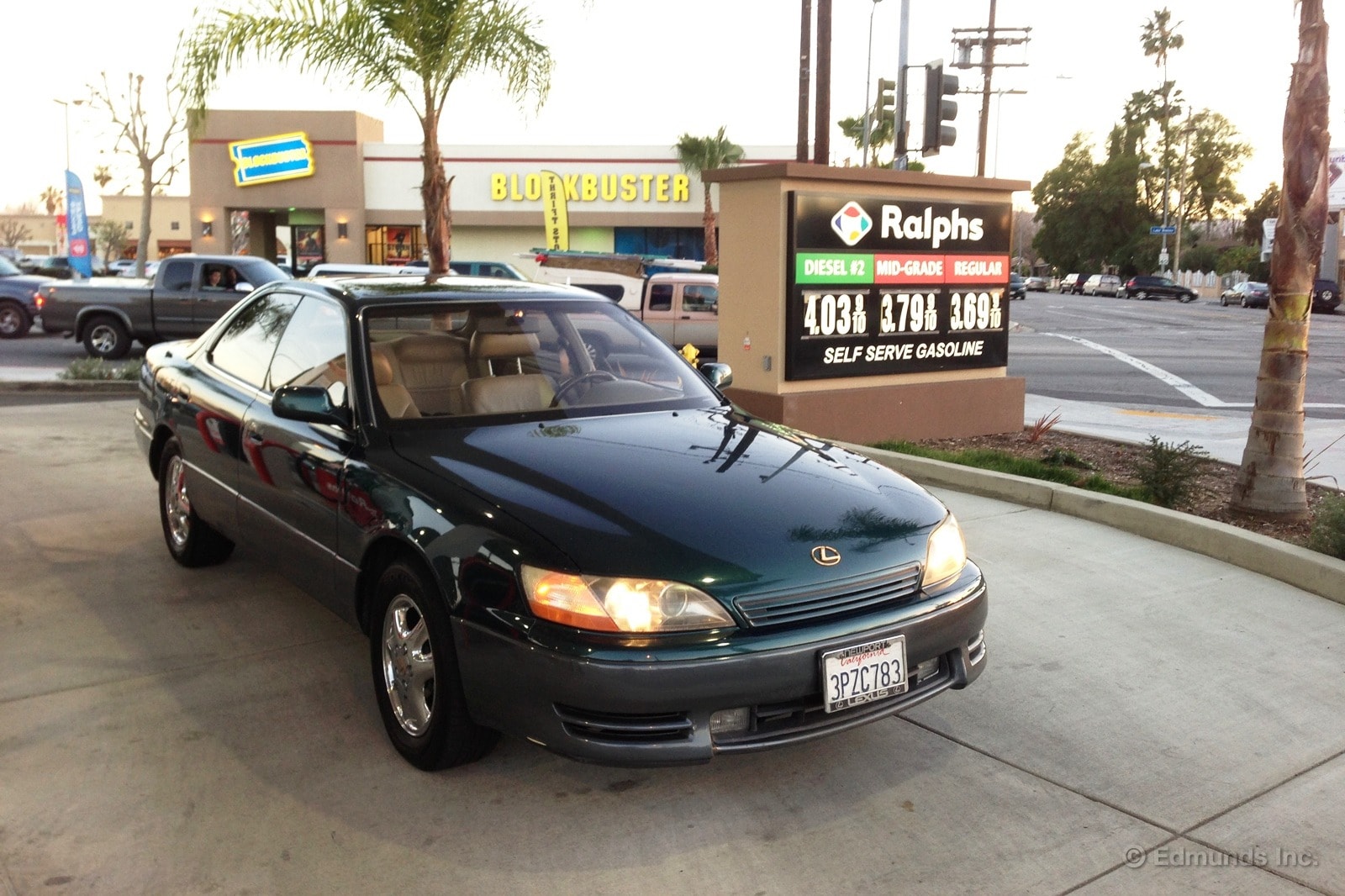
Our 1996 Lexus ES 300 didn't see much action on the road last month. It was only driven about 430 miles. This was partly due to the car being in the shop for a few days.
The ES 300 only had two fill-ups in January and it averaged about 20.7 mpg. This is down from our lifetime average of 24.9 mpg. I'm going to chalk this one up to the faulty oxygen sensor. The Lexus is capable of much better fuel economy.
In true "Debt-Free Car" fashion, I filled up the last gas tank at a Ralphs gas station. A gallon of regular at this station was 14 cents less expensive than the 76 down the street.

As Phil noted in a previous post, the cassette player doesn't eject tapes. It takes a bit of timing to finally dislodge a tape, hitting the eject button, then quickly lifting the cassette with a narrow fingertip to clear the opening. Not a big deal, especially since I'm one of the few on staff that still uses period-correct mixtapes.
The player itself is pretty good, I must admit. I was assuming that it would have an auto-detect feature for metal tapes, just like our NSX had, and I was right. I popped in a TDK MA-XG and up came a "METAL" indicator on the LCD display. Sweet.
The sound quality is quite decent, considering the analog sources. Set to Dolby noise reduction "B," there was little in the way of hiss. The "C" setting was not preferred, as it seemed to add some weird distortion. One thing that bugged me, though, was that the player wouldn't skip to the next song. It seems as though that function isn't working because it just fast forwards to the end of the tape.
It was a lot of fun reliving my adolescence through mixtapes with the new girlfriend. As with the Grand National trip, she remembered the lyrics way better than I could. I won't hold the ES 300 in as high regard as our NSX or Grand National, despite this association. This tired old Lexus never managed to win me over, and I doubt it ever can.
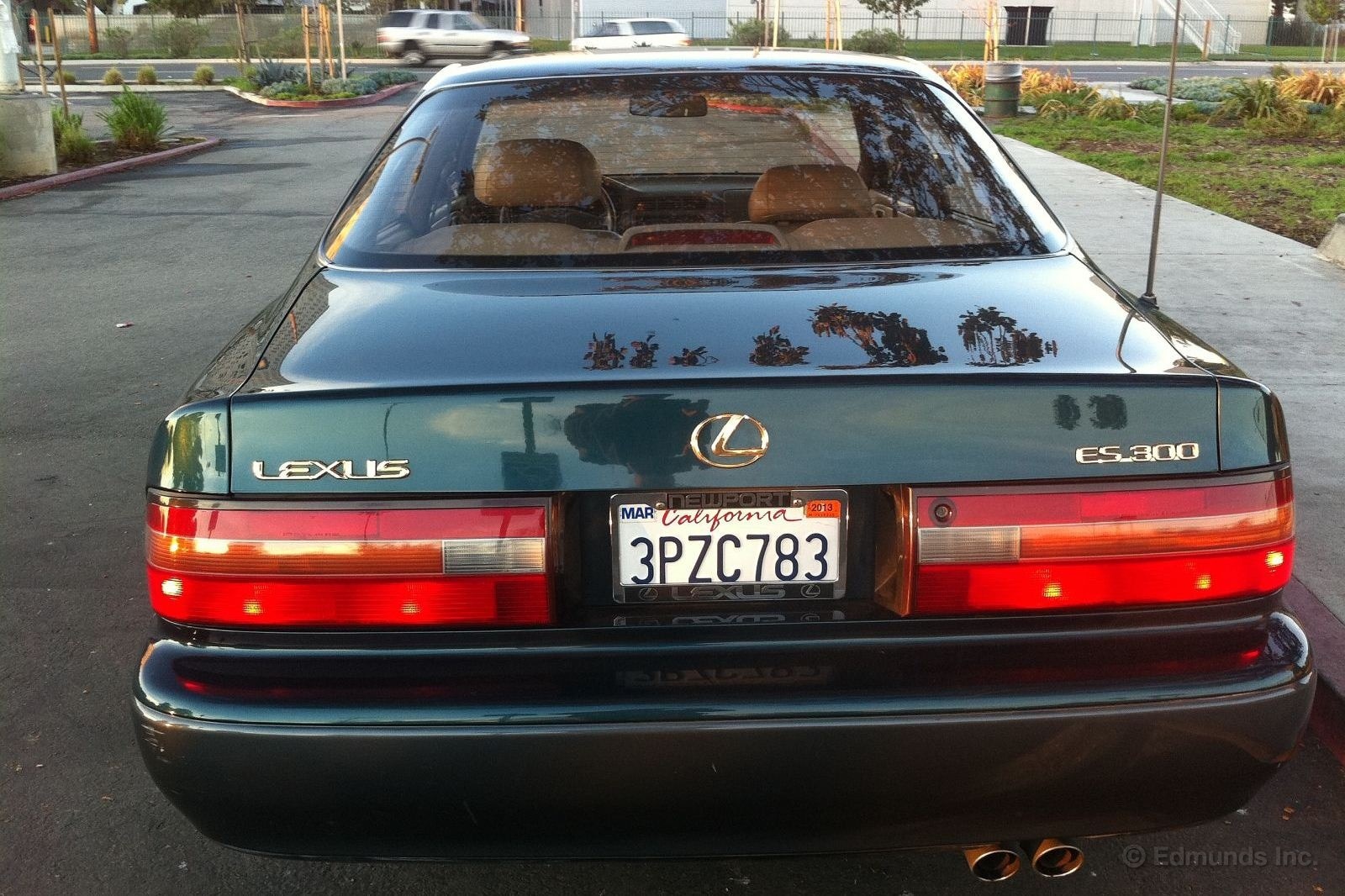
Notice anything about our 1996 Lexus ES 300 besides the stunning gold kit? Look at all that glass in the rear window. While it might not be as safe in an accident, the increased visibility might actually help avoid collisions.
When I drive this car, lane changes are stress-free. That's because I don't feel like I'm looking out at the world through a peephole of a Sherman tank.
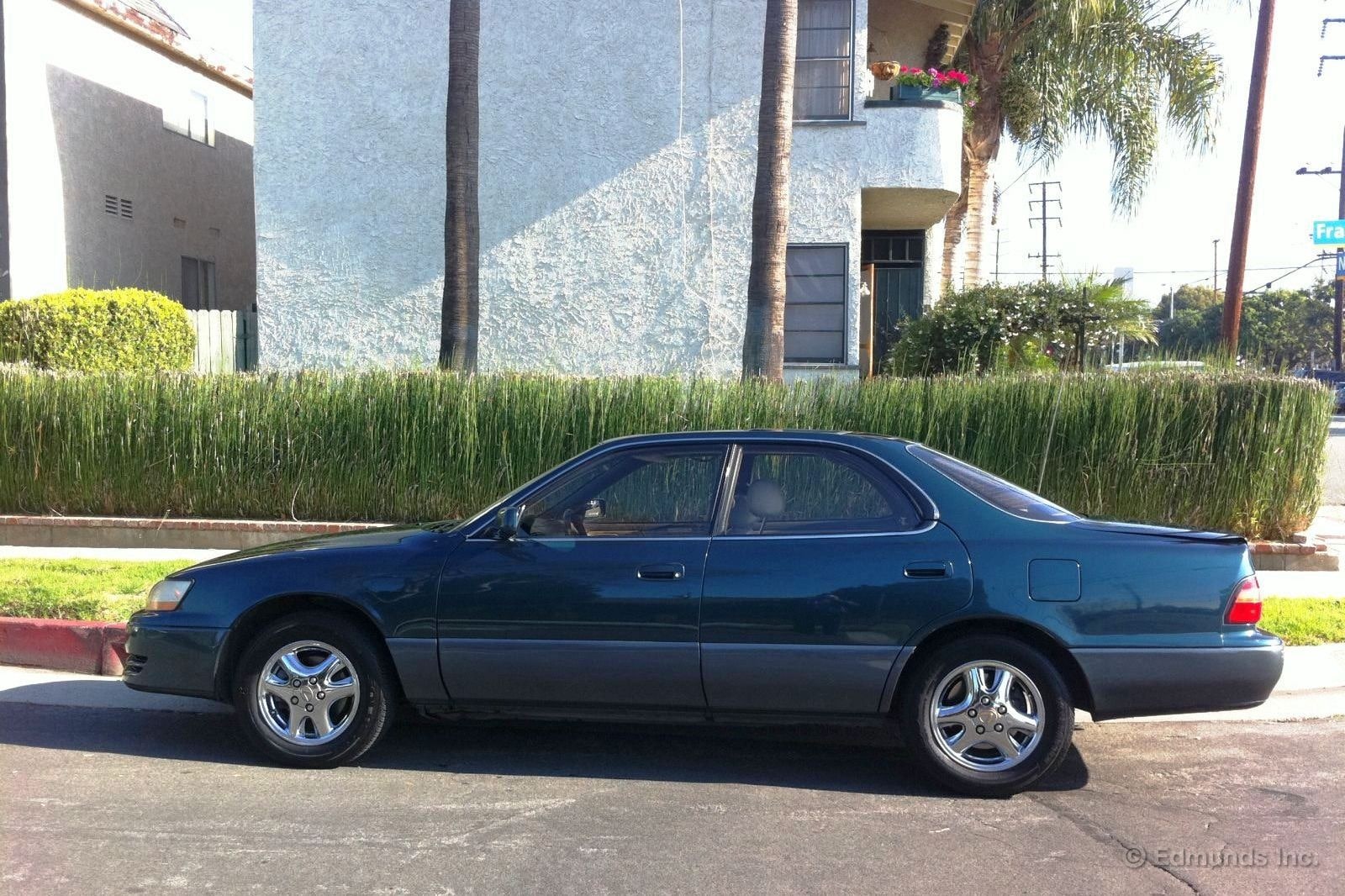
I've owned a lot of old used cars and I've noticed that, when there are a few problems, you feel like a car's on its last legs. But if you keep the faith, and fix the problems, it suddenly seems good as, well, not quite new, but at least back up to speed.
Such is life with our 1996 ES 300. As Ron described in his post another editor experienced a hard start problem. A short time later, the check engine light came on again! Oh man, it seems like this car's falling apart.
The engine code indicated that there was a vacuum leak, which could have been almost any loose piece of spaghetti under the hood. Or it could have been something major, like the charcoal filter under the exhaust system. And then again, maybe it was triggered by replacing the O2 sensor. We decided to reset the code and hope for the best.
Monday morning, after a weekend of driving, with no reappearance of the check engine light, I took it to the car wash for a quick bath. On the way back to the office, I noticed my attitude toward the old car improving. "How could I have ever thought it was down for the count?" I wondered. "This has plenty of life left."
But every couple of miles, I nervously glance at the gauge cluster, dreading the glow of the check engine light.
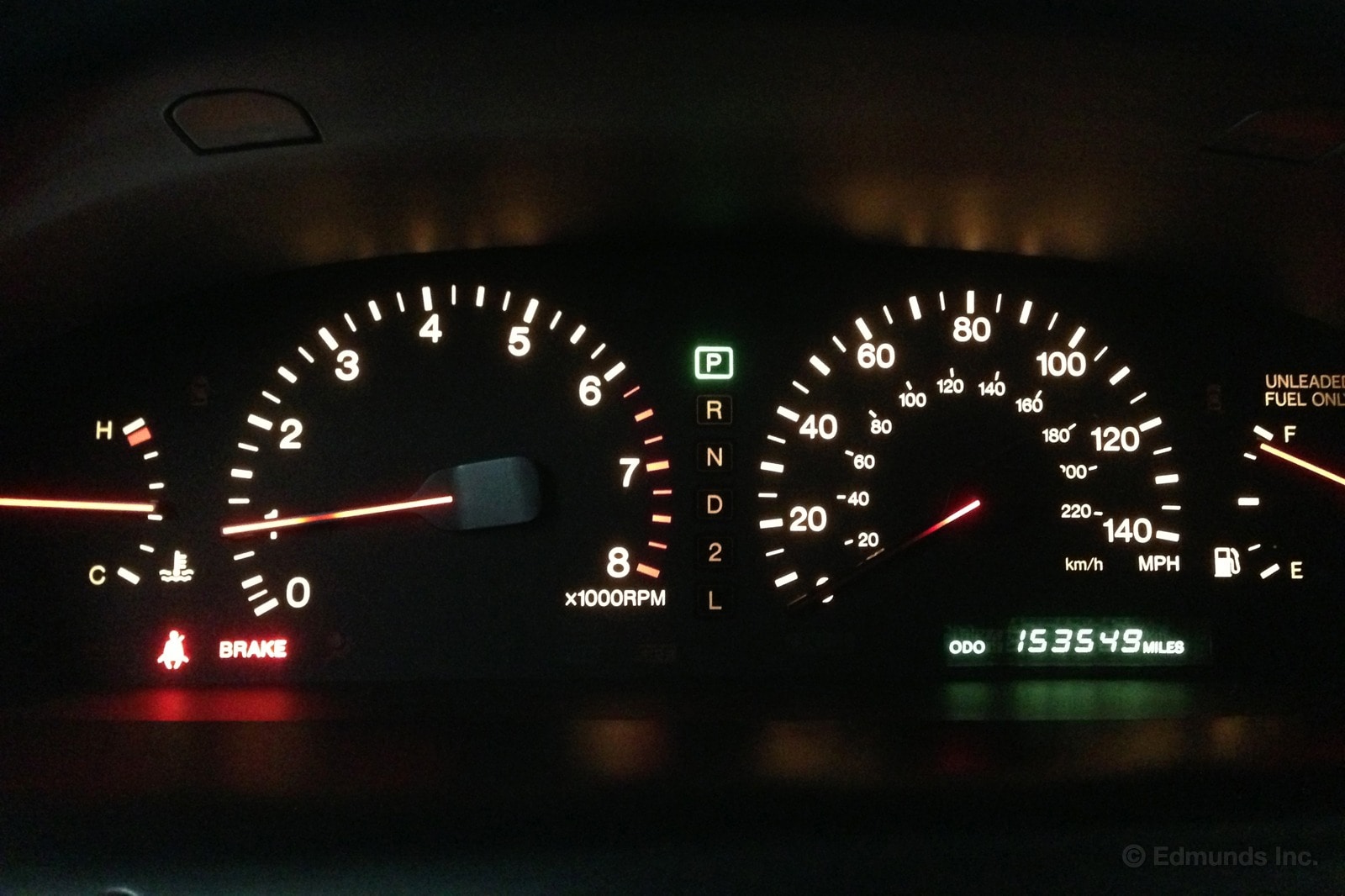
You're looking at the almost-like-new gauge cluster on our long-term 1996 Lexus ES 300. The lights had been in a slow state of deterioration and had even gotten worse than when Brent Romans, first pointed out that they were fading.
It was most evident on the speedometer dial, where nothing was visible up to the 80 mph mark. I generally kept up with traffic and if I saw the speedometer needle, I knew I was going too fast. Clearly, this needed to be fixed.
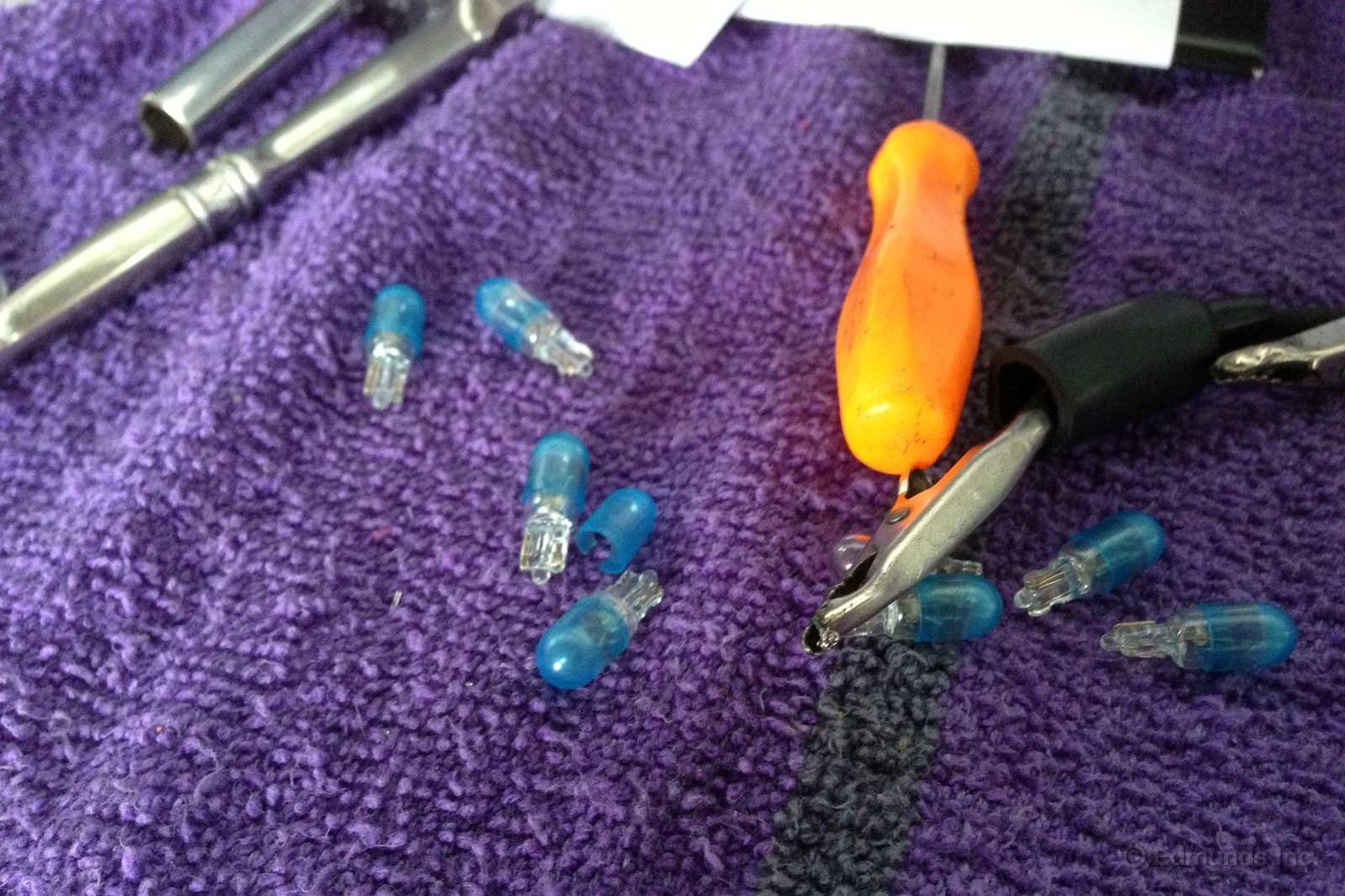
The last mechanic we went to said he wasn't able to repair it. Too specialized, I suppose. We had also seen someone on eBay who claimed he could repair it for $99, but we would have had to take out the gauge cluster ourselves and ship it to him. Who knows how long we'd be without the car?
My colleague, Phil Reed, thought of calling Sean McMullan, a paintless dent remover, who he interviewed for this article. McMullan has a network of mechanics he trusts and refers people to. He referred us to Alberto Garcia, owner of A&M Motors in West Los Angeles.
We took the Lexus to A&M Motors and a few hours later, we got a call from Alberto. He replaced eight bulbs behind the gauges at a cost of about $2 each plus labor. We'll still have to deal with the flickering and partially lit needle, though. According to Alberto, that component has a different circuit board and he would have to send it out to a specialist. I think we can manage with a needle light show.
We also asked Alberto to take a quick look at the engine and mentioned that the car wouldn't idle properly on cold starts. He noticed a disconnected vacuum line. It either came loose or wasn't re-attached when the O2 sensor was fixed. We hope this finally solves that issue.
The total cost with labor: $111.53
Days out of service: 0
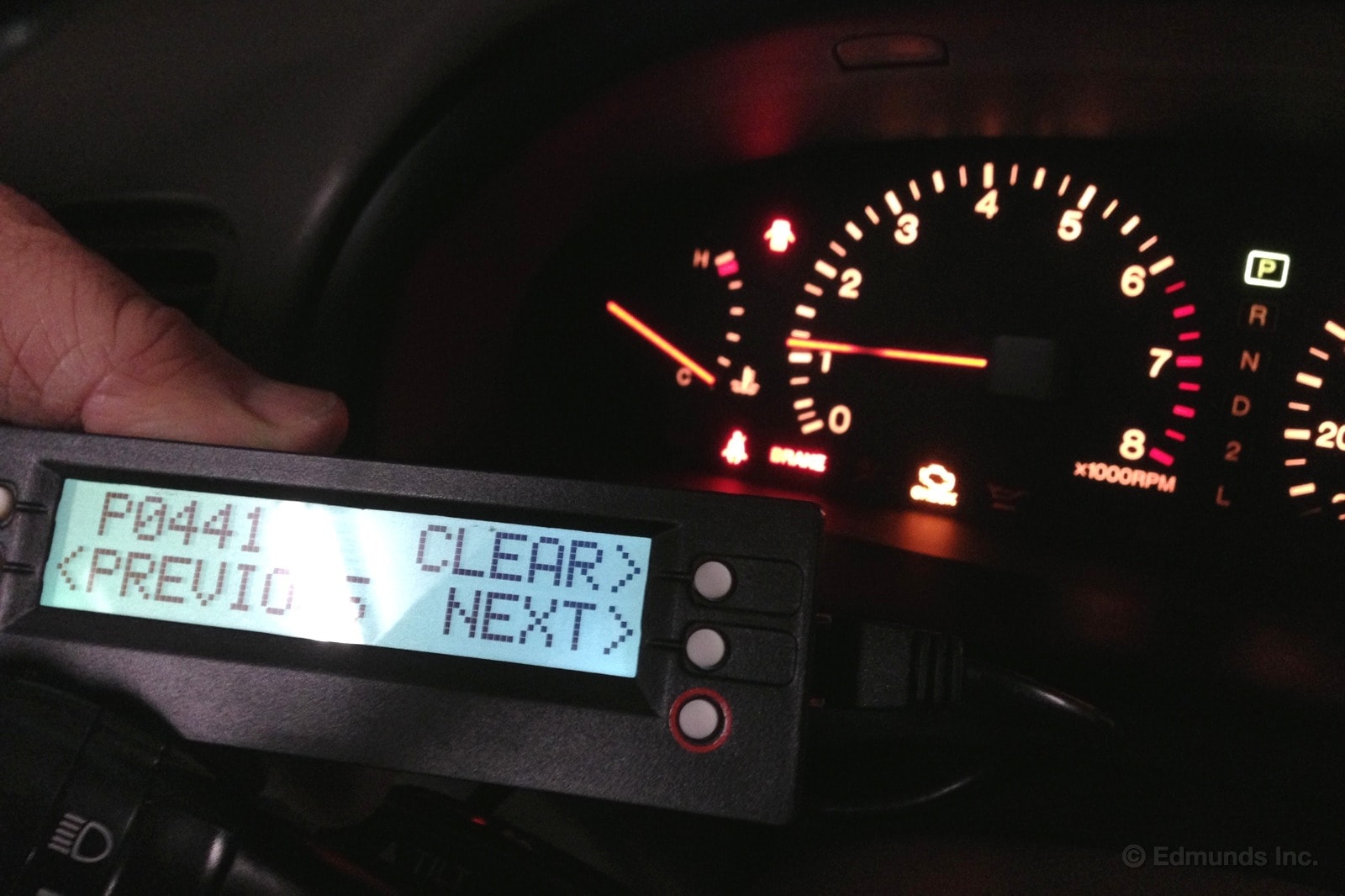
Just when you think you have an old car sorted out, it seems that something else always surfaces. The infamous "Check Engine" light is back on in our 1996 Lexus ES 300, just over a month after we cleared it for the oxygen sensor.
We have a ScanGauge code reader in the office, which we used to get more information about the light. The Lexus gave us a "P0441," code. This code has something to do with the evaporative emission control system having an incorrect purge flow. That's about all we know so far. The P0441 code could mean anything from a faulty gas cap (it seems to be fine as far as I can tell) to the need for a new charcoal canister.
The car drives normally, and if it didn't need to pass a smog inspection, I'd consider ignoring the light. But we're going to be selling the car soon and in California, it is the seller's responsibility to get it in smog-test-passing condition. Besides, taking care of this will better help us sell the car. Imagine going to inspect a car you want to buy and seeing a bright "Check Engine" light. It's a major red flag.
I'll be taking the car in to the mechanic next week and will report back with more details.
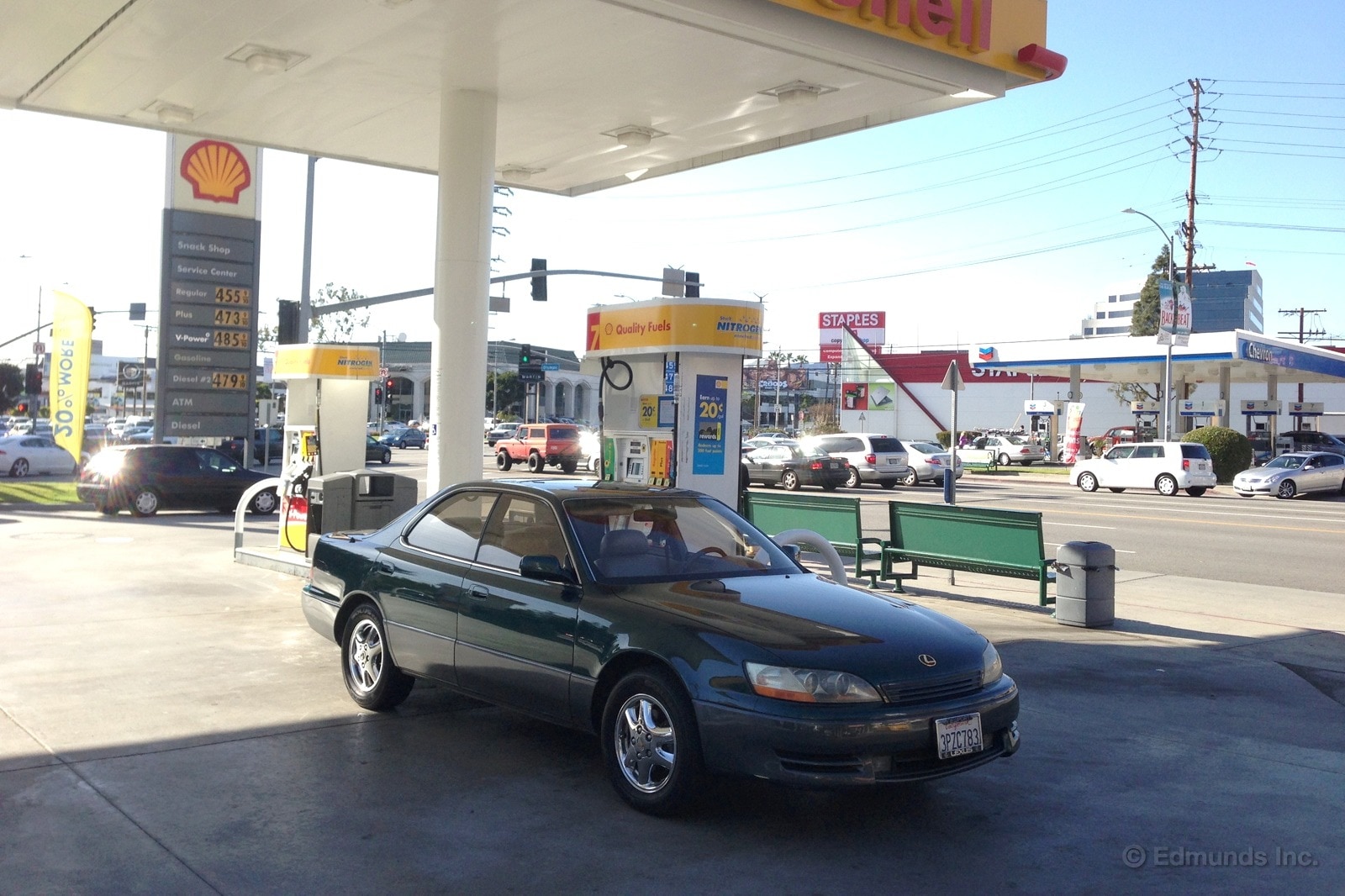
Our long-term 1996 Lexus ES 300 only went through a tank and a half of gas (417 miles) in February. Those two fill-ups averaged about 18.6 mpg, which is a bit lower than our lifetime average of 24.8 mpg. Still, our lifetime average is well above the revised EPA combined rating of 21 mpg.
This is partly due to the check engine light coming back on (It's fixed now, more on that in a later post) and partly due to some lead-footed editors.
Worst Fill MPG: 16.5
Best Fill MPG: 33.4
Average Lifetime MPG: 24.8
EPA MPG Rating (City/Highway Combined): 21
Best Range: 433.5 miles
Current Odometer: 153,676 miles
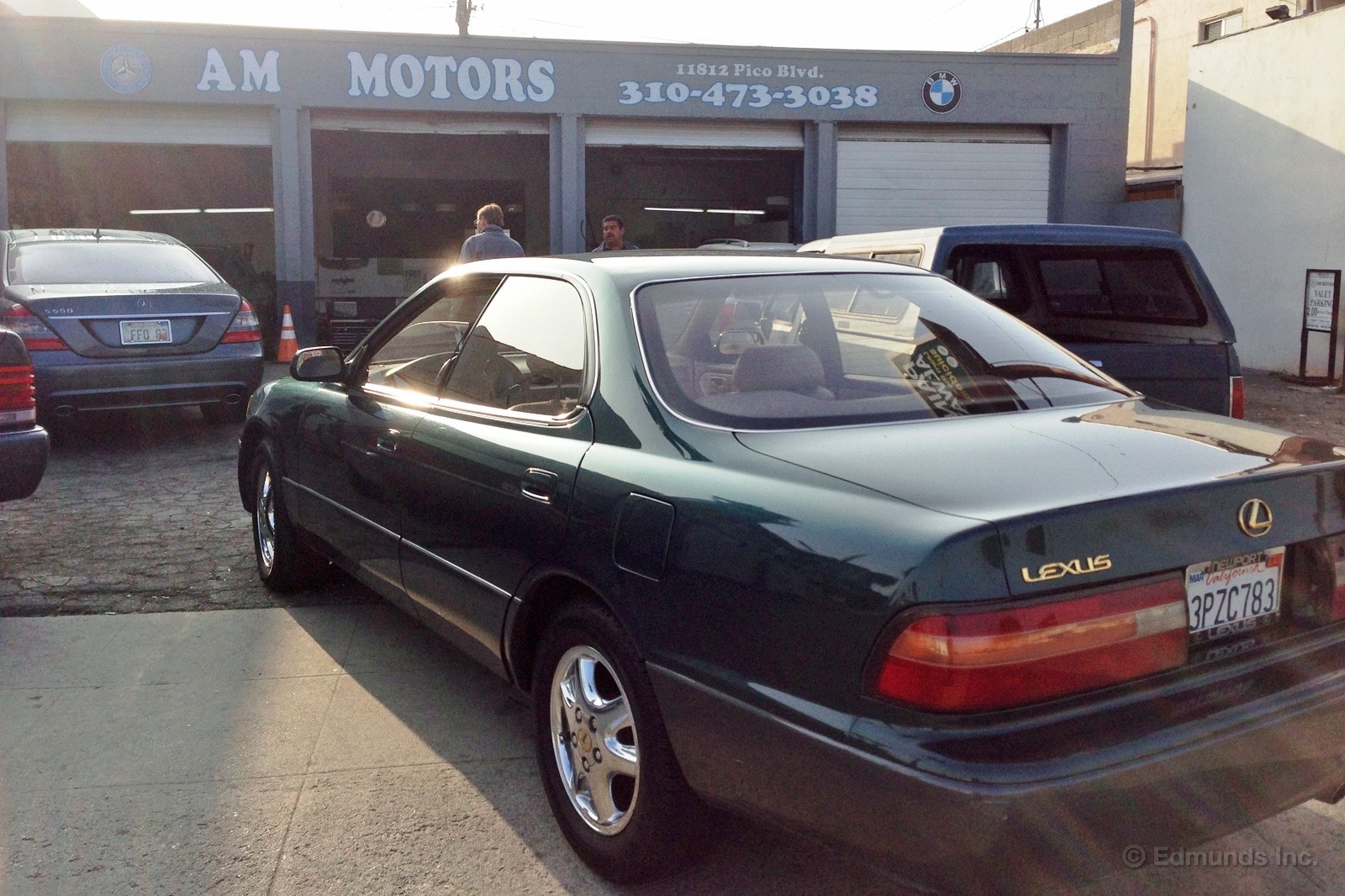
The key to keeping maintenance costs down on a car is to find a reputable mechanic and build a working relationship. Seems like a no-brainer piece of advice, but for us it hasn't always been easy to follow. We've taken our 1996 Lexus ES 300 to a number of mechanics, based on who was driving the car and where we were at the time.
We really liked the service we received from our most recent mechanic, Alberto Garcia, who repaired our gauges. We decided to have him examine the cause of a pesky check engine light.
To recap, the Lexus was giving a P0441 code, which was related to the evaporative emission control system. The mechanic called us to say it was fixed about an hour after we dropped it off. The problem was the exact same one that commenter "mdj61254" experienced in his car: a leaking vacuum hose. While the commenter had to pay $180 for the diagnosis, we got a nice surprise when we asked what our tab was.
"It was just a small hose, you can have it," said Garcia, of A&M Motors. "Consider it a Christmas present."
This was a low-cost part for him and not charging us was a nice gesture that makes us want to go back to his shop for any future repairs.
Days out of service: 0
Total Cost: $0
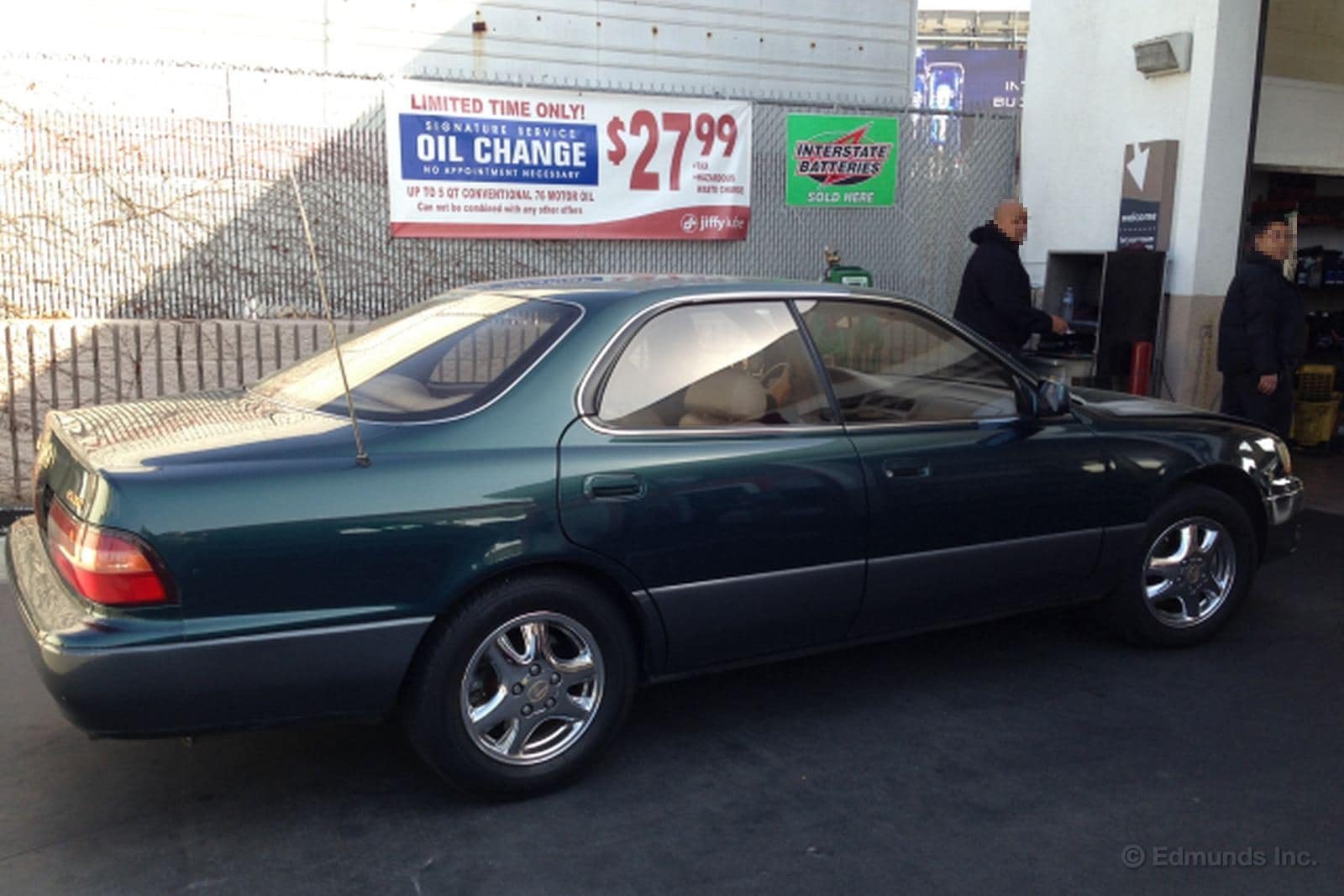
In our popular article "Stop Changing Your Oil," we were critical of Jiffy Lube for recommending too-frequent oil changes. We had heard that Jiffy Lube had changed; that its techs would give customers manufacturer recommended oil change intervals. Since we needed to get an oil change before getting a smog test — and needed that inspection before selling it — we decided to go back to Jiffy Lube and see how things had changed.
We even decided to try playing "gotcha journalism." Here's what happened.
When the sales guy approached us we said we didn't know if we needed an oil change or not. We said we weren't sure what the intervals were. The sales guy said the best way to tell was to look at the color of the oil. This, by the way, isn't entirely true. See #4 in "Urban Legends about Oil.". But we took it as a good sign that he wasn't just going to default to just-go-ahead-and-change-it mode.
The tech guy then looked up the oil change interval on his computer and said it was either 5,000 or 7,500 miles depending on how we drove it. This, of course, is the good old severe versus normal driving schedules. In the past, quick-change oil shops have tried to get everyone on the severe schedule because it means more business for them. But now, we were being told by the technician, "We can set the sticker for whatever you decide." Eureka! This is just what we wanted to hear. No more 3,000-mile intervals glaring at us from the little sticker in the corner of the window.
Here's another nice surprise. We priced an air filter at an auto parts store before heading to Jiffy Lube and found they cost $14.99. The Jiffy Lubsters installed one for $16.99. It was worth the two extra bucks to have them pop it in. The total bill was $51.48 and we were on our way in a half hour.
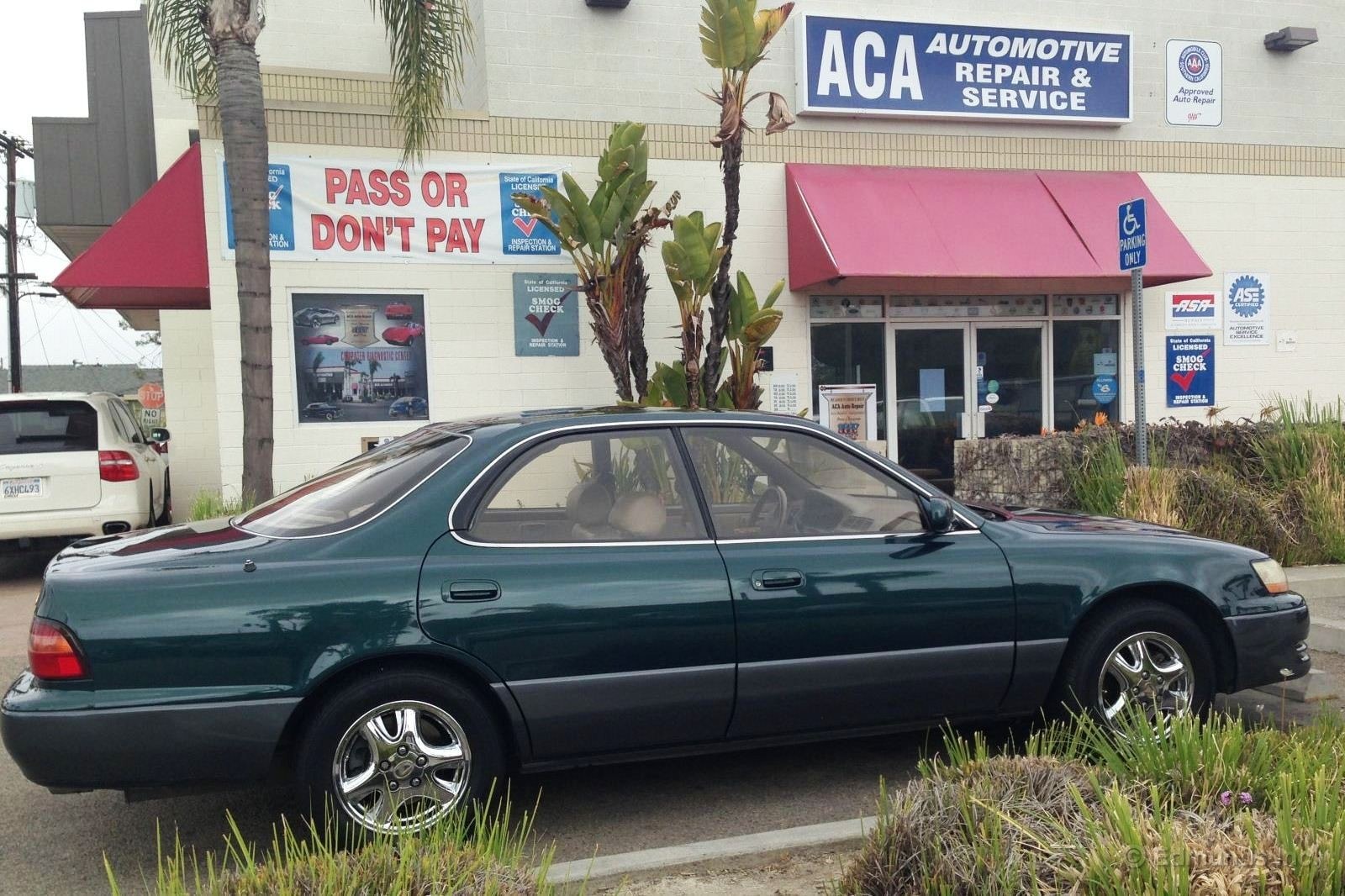
We're getting ready to sell this old guy and we had to get a smog test before we did the deal. We were a little nervous about whether it would pass, what with all the "issues" we've had lately (mass air flow sensor, check engine lights, O2 sensor etc.). So it seemed prudent to change the oil first and do a little highway driving. One smog test expert explained that long drives are helpful because it allows the catalytic converter to heat up enough to burn up all of the oil residue left from the inevitable "blow-by" in an older engine.
Highway driving is my specialty and with the ES nice and hot I brought it into ACA in Long Beach, Calif. They weren't the cheapest shop, but they were perhaps the nicest smog guys I've ever dealt with. While they were doing their thing, I had some Awesome Sushi (actually that's the name of the place) across the street. While the last piece of raw fish was wriggling down my throat my phone rang with the news: "You passed." The smog test was $71. The sushi was $12. It took one hour.
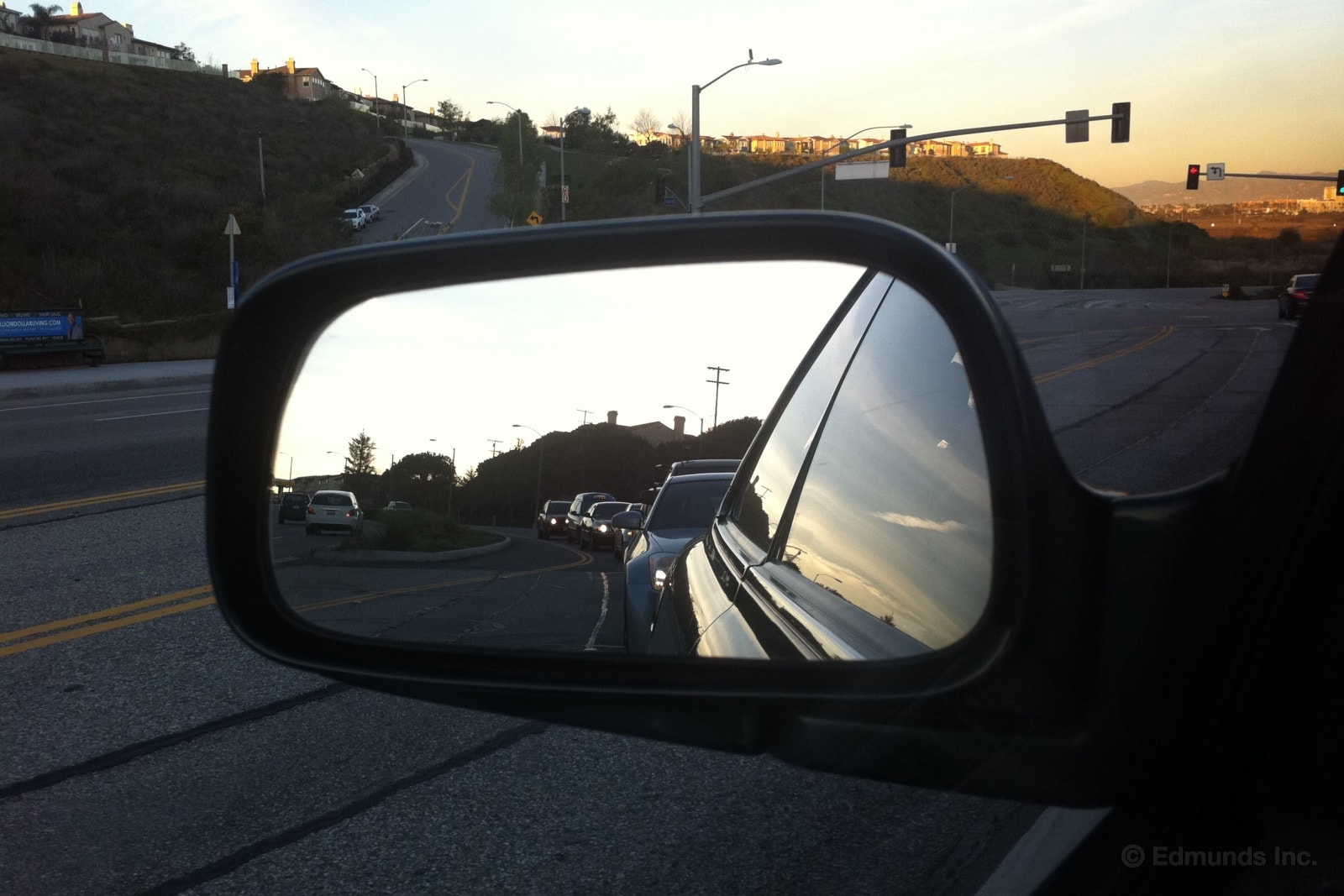
I took this picture to riff on how small the mirrors are in this 1996 Lexus ES 300. But now it seems a fitting farewell photo as the car leaves our fleet.
I drove a lot of miles in this car, both around California, and coast to coast. If you mention this car, I flash back on the windy spring day I drove it across Wyoming or the morning I parked it by the Atlantic while I ate fried clams with my father. Sure, there were the hard times too, like watching coolant pour out of the back of the engine in Detroit. Or the pesky check engine light that just wouldn't go away.
But the undeniable fact is that somehow this big hunk of machinery, which is just a collection of metal and leather and paint and glass, becomes a part of our lives. When it's gone we miss it. At least we have the memories, and a few photos, to remember it by.
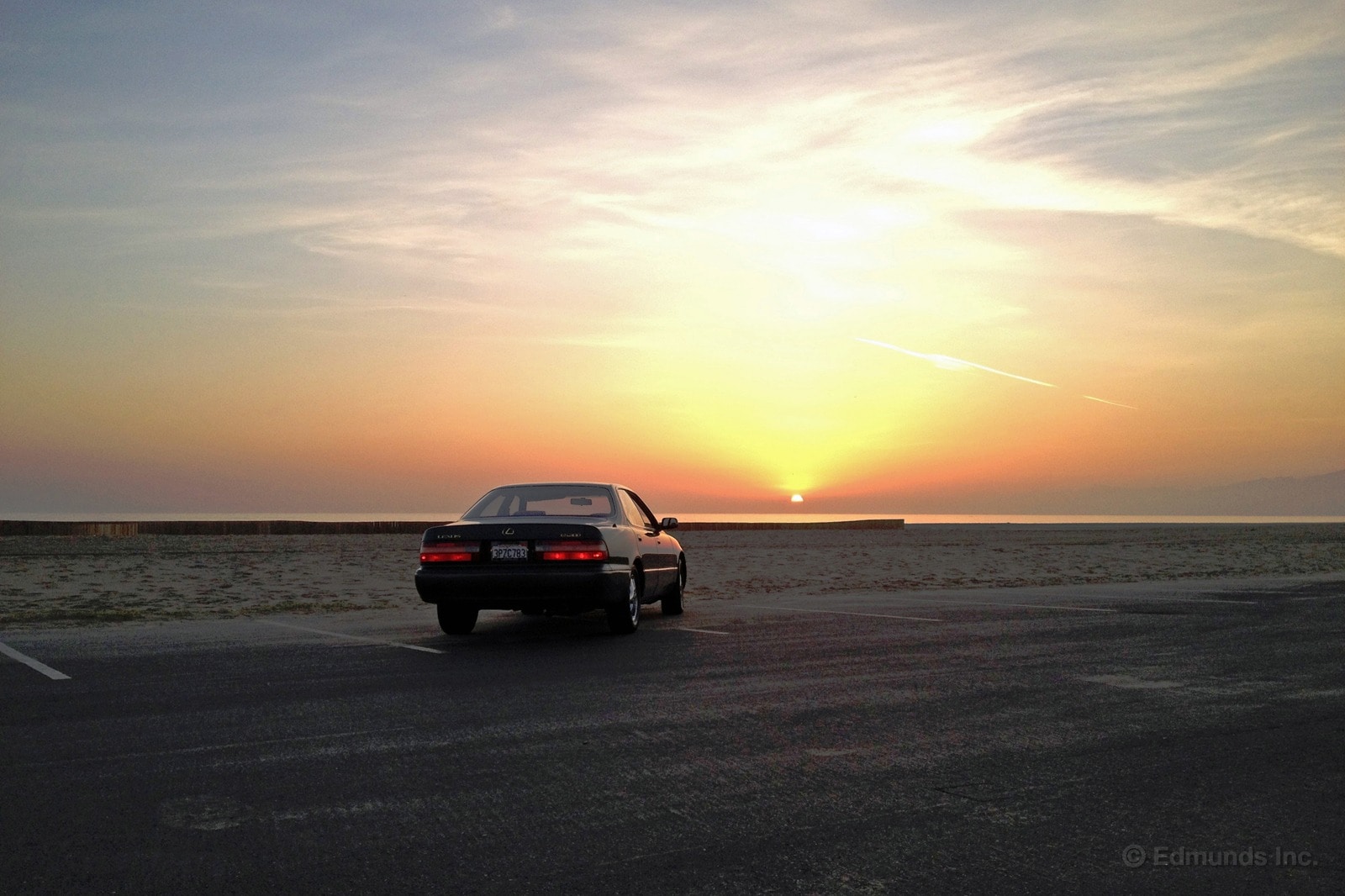
Our long-term 1996 Lexus ES 300 rode off into the sunset this week. An Edmunds employee bought it, and in the process, the car made a bit of Edmunds history.
We've offered plenty of nice cars to our employees, and you would think they'd be lining up to purchase them. Among our offerings were a Dodge Challenger R/T, a Pontiac G8, and an Acura NSX. But when it came time to buy, we've never had more than one interested employee — until now. Then again, there had never been a car that was such a screaming deal.
If we had sold the Lexus on Autotrader, we would have listed it for about $4,000. I'm fairly confident we would've ended up accepting an offer of somewhere around $3,300. But our standard protocol is to offer the cars first to employees before we turn to Carmax or a private party sale.
We listed the Lexus internally at $2,668, which is the Edmunds private-party True Market Value (TMV). About five people responded to the listing, but in the end it came down to two employees: Bob and Blake.
Edmunds policy states that when there is more than one interested employee, the matter will be decided by a drawing. This way, no one can be accused of playing favorites.
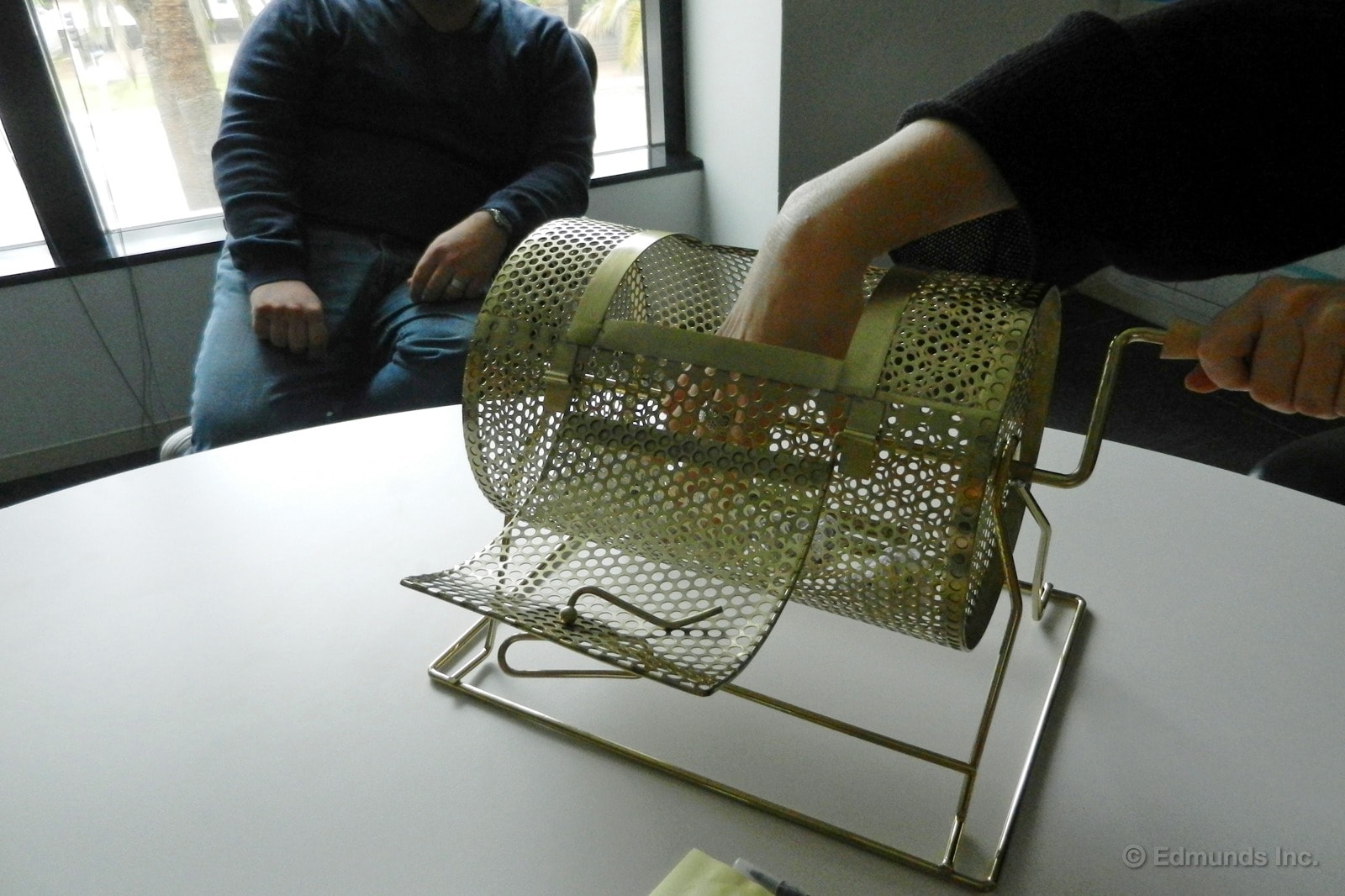
We dusted off an old raffle cage that's used for events at the office and called in the VP of HR to supervise the proceedings. She placed three crushed paper balls, with each person's name on it, in the cage. After a couple of spins, we had a winner: Bob.
Bob was looking for an inexpensive daily driver that would replace a Honda Civic in his garage. His main car is a Mercedes-Benz E55 AMG, but is too much of a gas guzzler to drive on a regular basis. The Lexus would likely deliver twice the fuel economy of the Benz.
Cars are machines, yet somehow we build connections to them. As the co-author of the Debt-Free Car project, I felt a sense of attachment to this car like none other in the fleet and I'm sad to see it go. It was fun to drive and it possessed a '90s-era charm that I was really into.
I put the second most number of miles on this car (Phil Reed and his cross-country trip take first prize). If things broke down, I was one of the "go-to" guys for handling repairs. If someone was down on the car, I'd be the first to defend it.
I know this car was well-liked by the readers, too. It generated plenty of discussion. Sometimes, we had different interpretations of our "imaginary owner" and how to handle repairs, but it was all good.
I gained a better appreciation of aftermarket parts and independent mechanics. I had always been an OEM guy, since that was where we take other fleet cars. I also learned how helpful message boards can be in troubleshooting issues.
We drove the Lexus a total of 18,394 miles, far more than the 15,000 we had originally set for our goal. In a perfect world, we'd keep it another year and see how the costs amortized. But our long-term cars have always been one-year snapshots of ownership.
I'll hold back my overall conclusions about the project and its costs for the full-length wrap-up later this month. Stay tuned.
Feel free to give your thoughts on the Lexus and also tell us what you'd like to see us do if we pursue another used-car project.
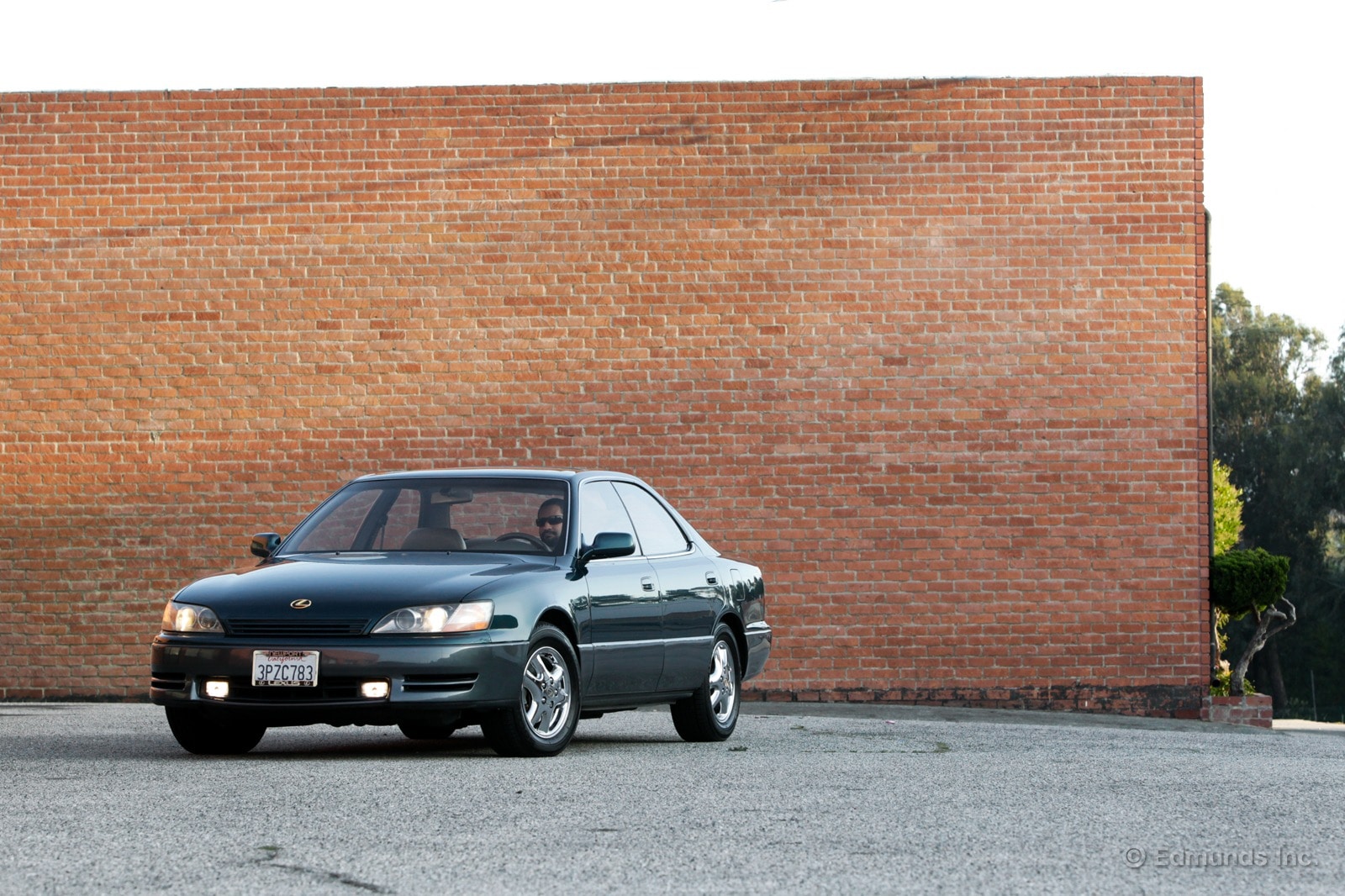
The "Debt-Free Car Project," featuring our long-term 1996 Lexus ES 300, has come to a close. After selling the car, I promised that I would give a final breakdown of all the maintenance items and our overall conclusions on the project.
In this chapter, I discuss the final repairs, the sale of the car and determine whether or not we can call the project a success. Frequent readers of our long-term blog may already be familiar with the final repairs and selling process, so feel free to skip to the conclusions.
Read more about the Lexus ES 300 here on Edmunds.com:
The Debt-Free Car Project Chapter 8: Wrap-Up
Final Odometer: 154,206 Miles